Are you planning on walking in Edinburgh and not sure where to start?
Deciding on the must-see spots and optimizing your time can be challenging. And that’s where’s where we come in.
Edinburgh is a city with many faces, each one inviting you to take a stroll and discover its unique charm. Whether you’re navigating the bustling Royal Mile or seeking the calm in the hidden pretty pockets like Duddingston Village, walking in Edinburgh is an experience you won’t forget.
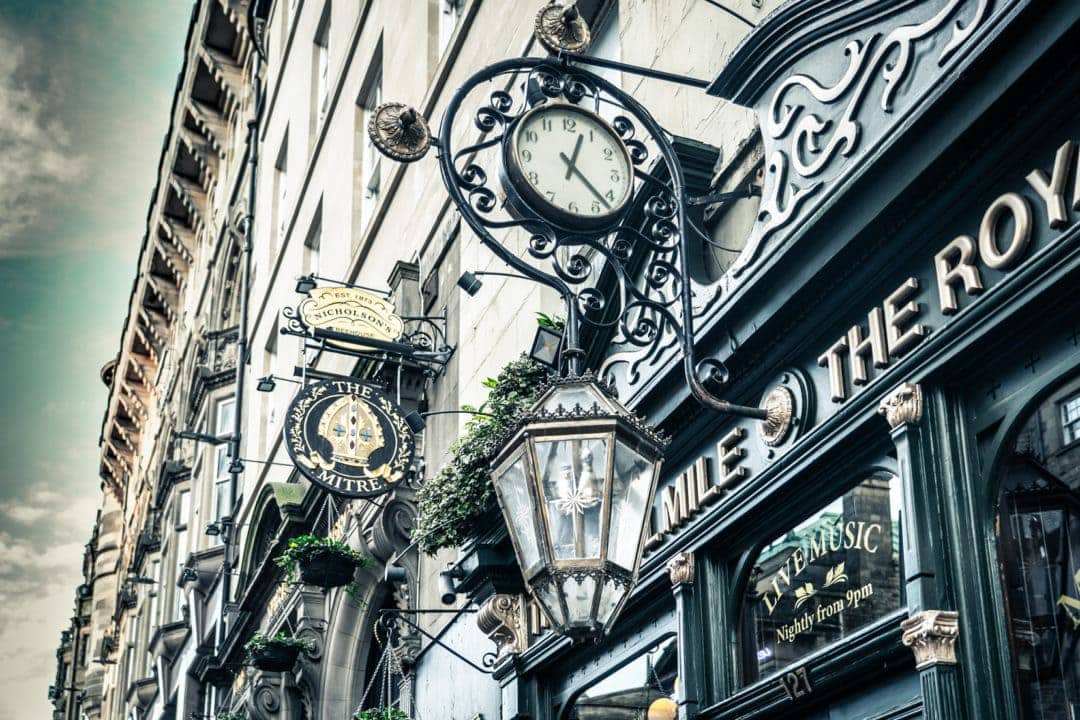
Before setting foot on Edinburgh’s cobblestone streets, we poured over maps, read reviews, and did all the research. Then, we walked around Edinburgh over two days, testing each route and spot to ensure they’re worth your time.
So, this guide isn’t just a list; it’s a tried-and-tested itinerary for an unforgettable self-guided walking tour of Edinburgh.
What’s Included in this Edinburgh Self-Guided Walking Tour?
- Over 20 Must-Visit Spots: All marked on a handy map for easy navigation
- Areas Covered:
- The Royal Mile (Red markers on the map)
- Grassmarket & Old Town Area (Grey markers on the map)
- Arthur’s Seat (Dark turquoise markers on the map)
- Calton Hill (Brown markers on the map)
- Duddingston Village (Purple markers on the map)
- Dean Village & Water of Leith Pathway (Orange markers on the map)
- Best Walking Tours: Highlights and insights for those who want to dive deeper
- Visual Inspiration: Loads of photos throughout to fuel your wanderlust
- Useful FAQs: All your Edinburgh walking queries are answered
- A Personal Note: I was reflective after my journey through Edinburgh’s streets. The city is undeniably beautiful, but it also made me ponder my own romanticised notions of it. More on that later.
Walking in Edinburgh Map
We’ve included a detailed map to help you find your way.
Each area is colour-coded, making it easy to plan your route. And the best part? All these spots are within a comfortable walking distance from one another.
Self-Guided Walking Tour in Edinburgh
On this self-guided walking tour of Edinburgh, we climb Edinburgh’s extinct volcano, find the best spots for amazing views of the city and discover plenty of Edinburgh’s past along the way.
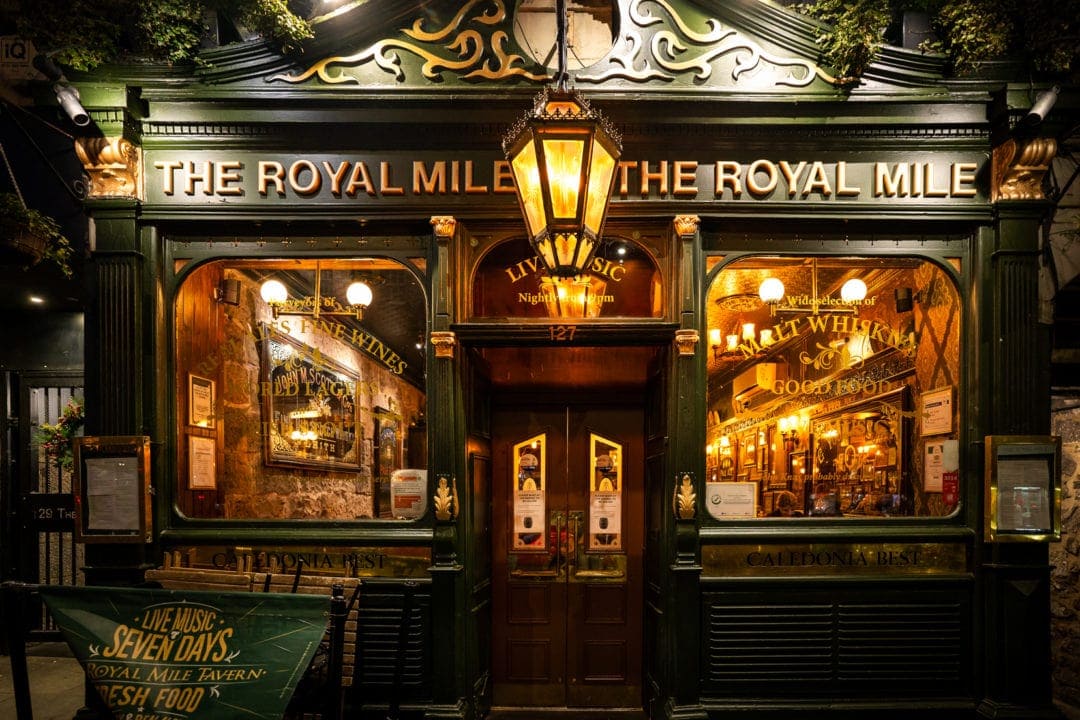
1. Edinburgh’s Royal Mile
Where better to start a walk in Edinburgh than along the famed Royal Mile?
Normally busy with tourists, it has plenty of shops full of tartan, whisky, shortbread, cuddly highland coos and everything Scottish.
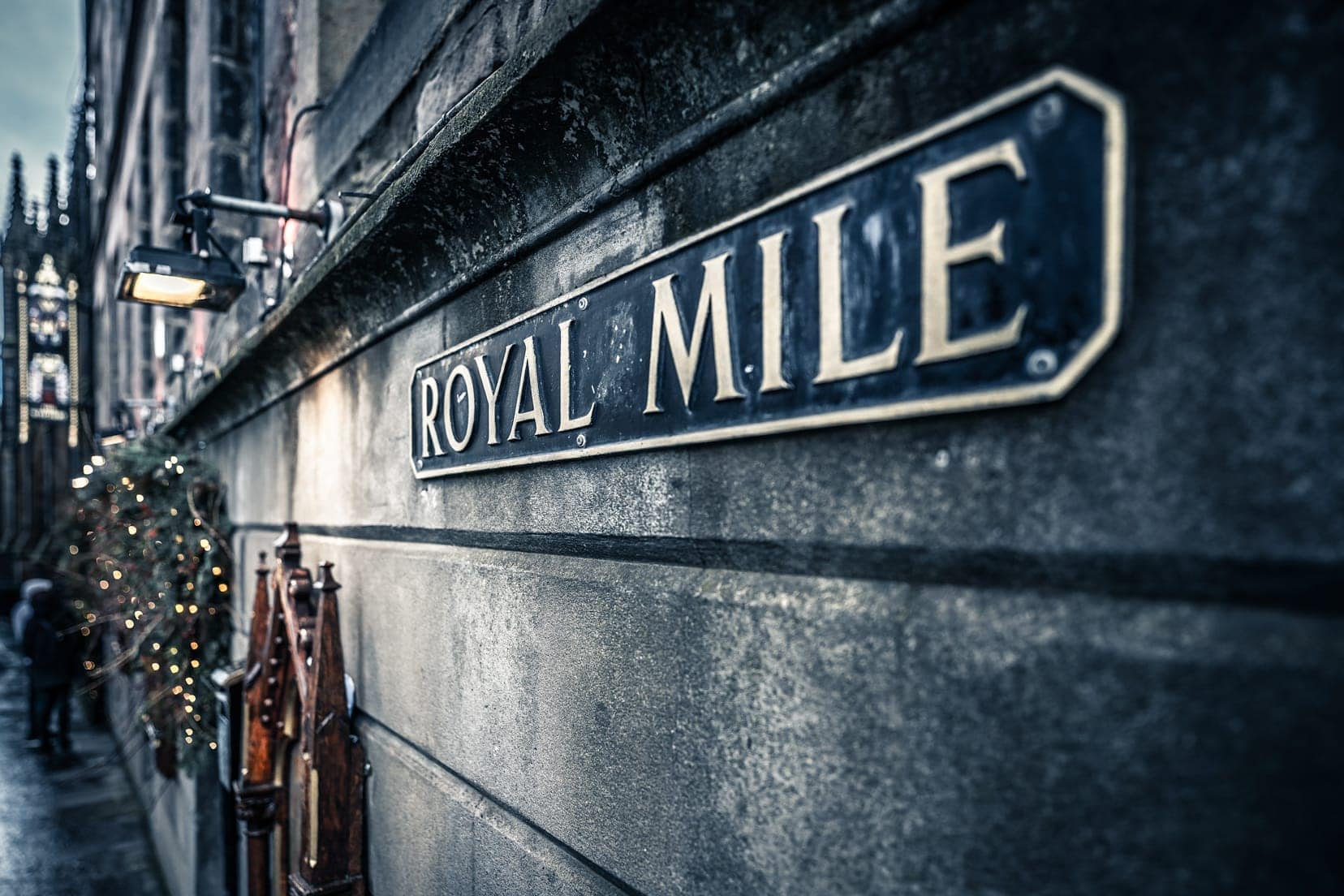
You’ll also find traditional Scottish Taverns dotted along the mile, where you can try hundreds of types of whisky and sample good old Scottish favourites such as Haggis, neeps and tatties (Haggis, mashed turnip and potatoes), a tasty fish soup, Cullen Skink, and of course, you have to try Scotland’s favourite… a deep-fried Mars Bar.

Interesting Stops Along the Royal Mile
This part of the walk takes you along Edinburgh’s main street, the Royal Mile and includes the following:
- Holyrood Palace
- Parliament House
- Canongate Building Quote wall
- Dunbar’s Close Gardens
- Edinburgh Museum
- Bakehouse Close (Outlander filming location)
- Canongate Kirk
- Writer’s Museum
- World’s End Pub
- Edinburgh Castle


Holyrood Palace
The Royal Mile is punctuated at the eastern end by Holyrood, where you’ll find the modern architecture of the Scottish Parliament Buildings, alongside the rather more historic Holyrood Royal Palace, the king’s official residence in Edinburgh.
👑 To explore Holyrood Palace and to learn more about its historical dramatic events – book your ticket and audio guide here| ⭐️ 4.8/5 star reviews | ⏰ About 1.5 hours
At the other end of the Royal Mile, at the top of Castle Hill, Edinburgh Castle woos the crowds with its tales of soldiers, battles, and the kings and queens that once walked its halls.
Although named the Royal Mile, the mile refers to the old Scot’s Mile, used in the 18th century, which is equivalent to 1.8 kilometres. Nowadays, the shorter English mile of 1.6 kilometres is used.
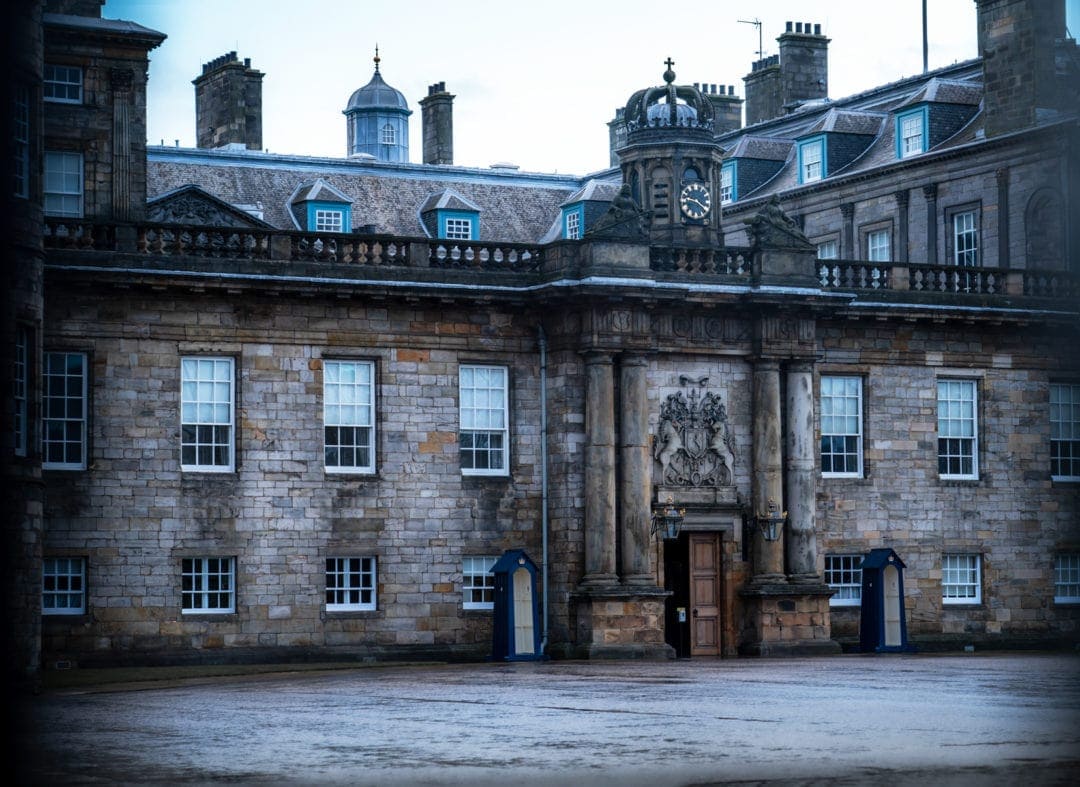
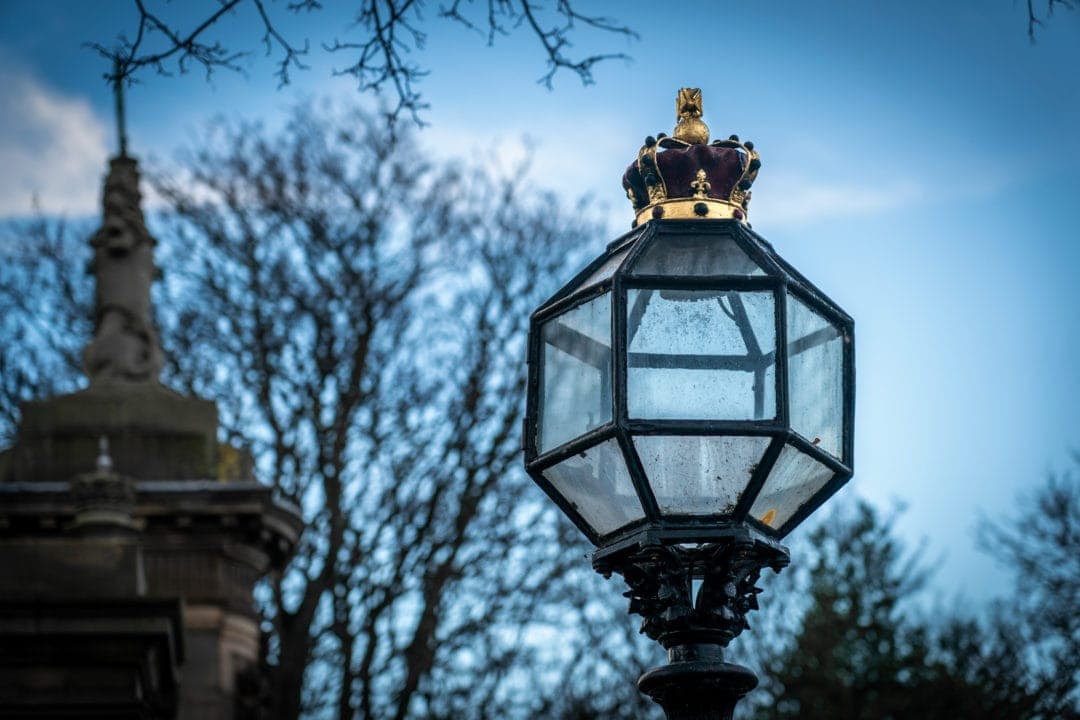
Parliament House

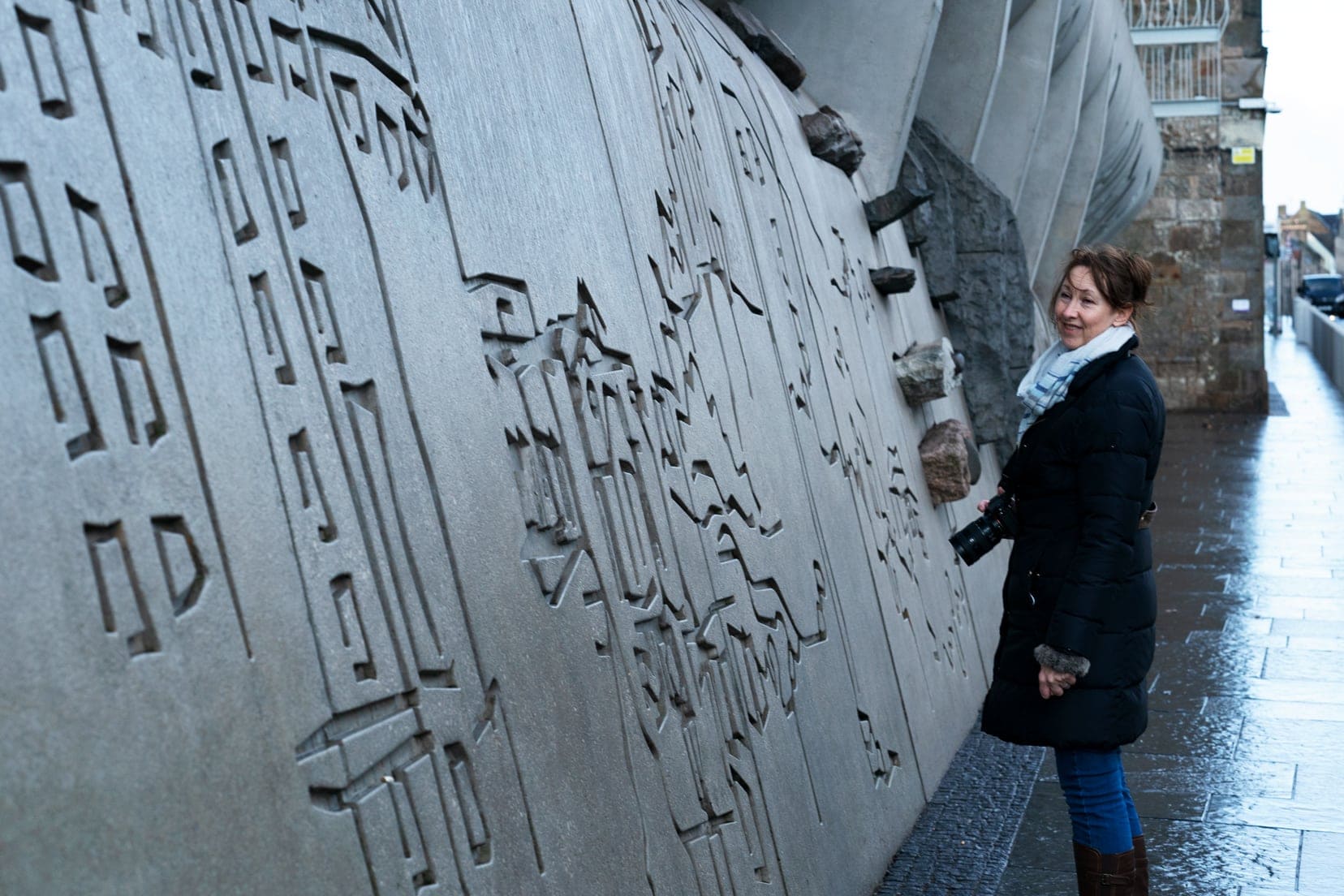
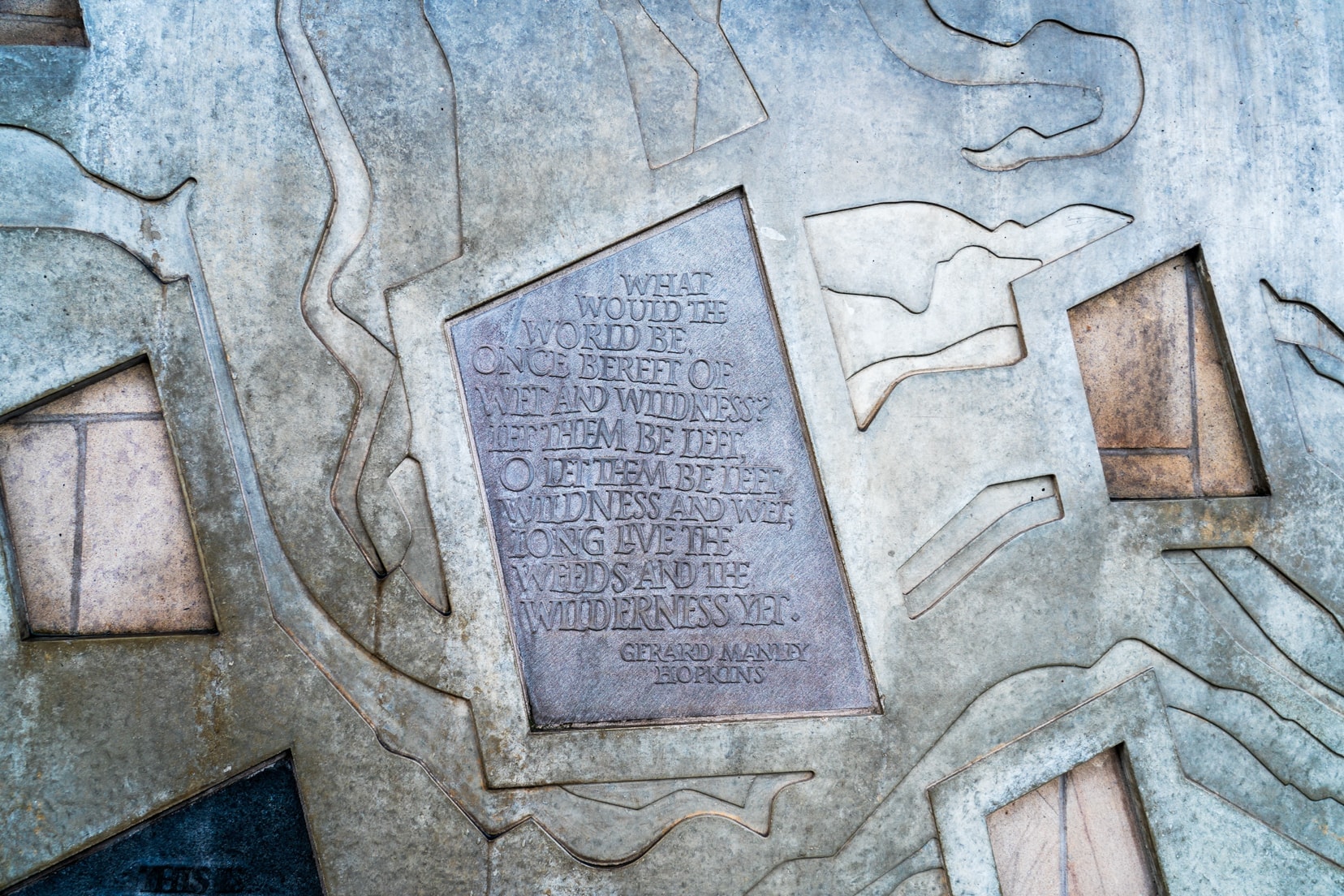
Planning a Trip to Scotland?
🚗 Hiring a car? We recommend getting a quote from DiscoverCars
🚐 Hiring a campervan? We recommend Motorhome Republic
⛑ Arranged your travel insurance? Compare quotes from World Nomads & Safetywing
🪪 Order your International Driver’s Licence online here
🏩 Booked your accommodation? We use Booking.com to find the best deals
🐾 Is someone pet-sitting for you? 🐾 We use and love TrustedHousesitters
(Get 25% off at checkout for new memberships with our discount code: LIFEJOURNEY25)
Dunbar’s Close Gardens
When walking along the Royal Mile, take little detours off into the various wynds, closes, courts and alleyways branching off the main route. You’ll find hidden gardens, historical paths, cemeteries and even filming locations from Outlander.
As you walk up the hill, you’ll come to a hidden garden, Dunbar’s Close Gardens, a quiet place of solitude off the busy street. From here, you have great views across to Calton Hill and its Grecian-style buildings.
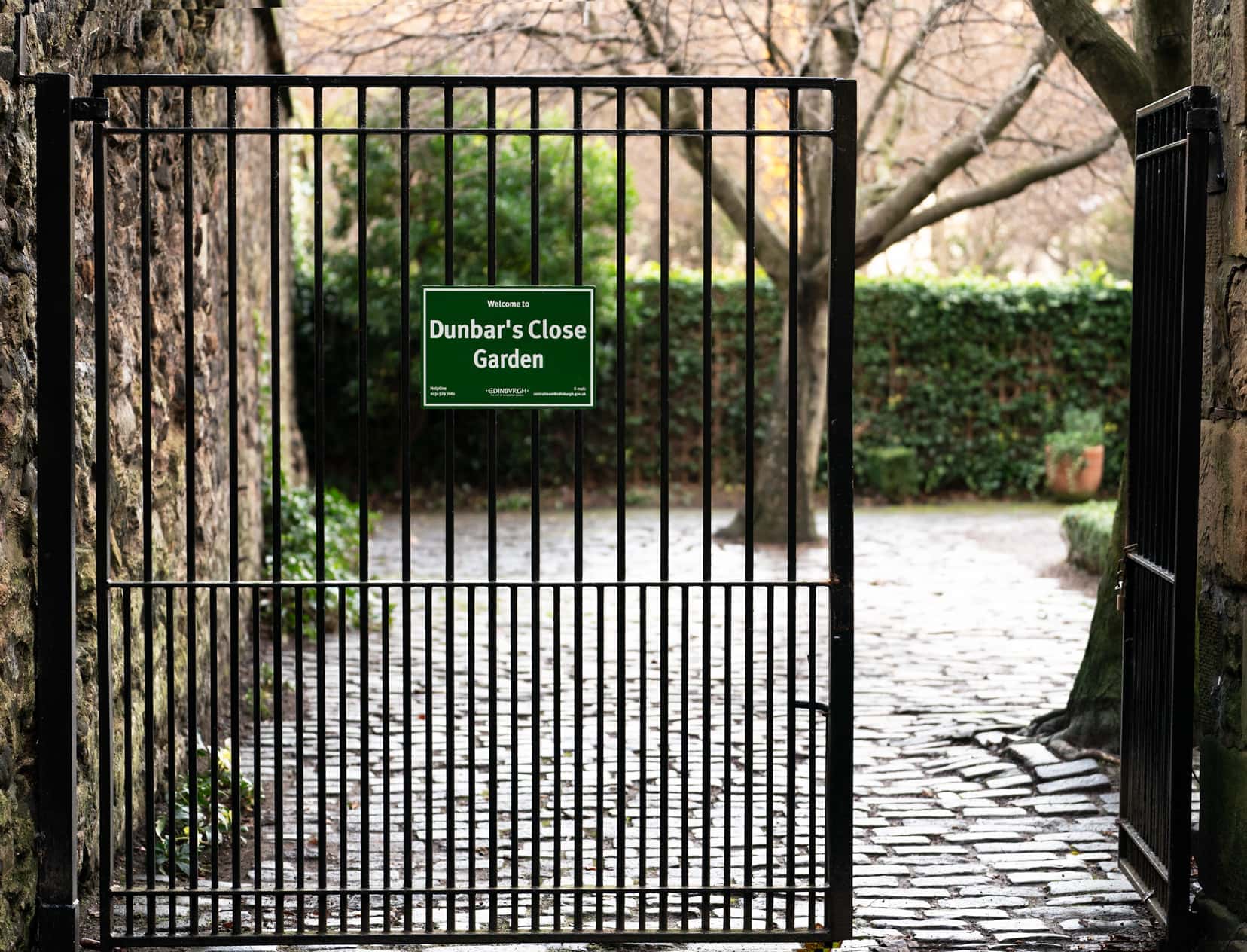
Bakehouse Close
A little further on, just past the Edinburgh Museum housed in a 16th-century house, you’ll find Bakehouse Close. Fans of the hit series Outlander will recognise this close because it was here that Claire was reunited with Jamie in his Print Shop.
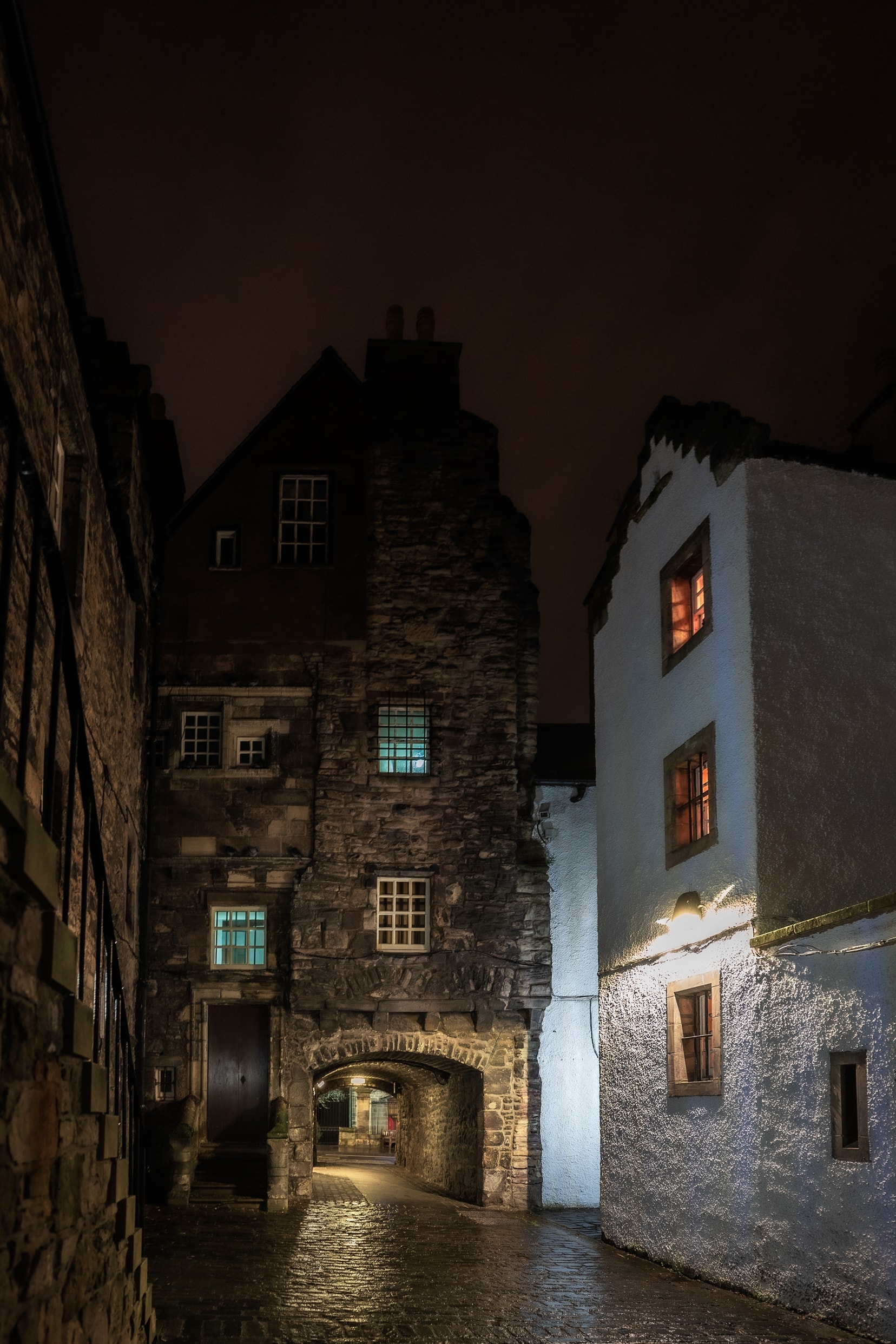
💡Lifejourney4two Tip: We visited at night so we could soak up the ambience without any tourists. Taking shots without waiting patiently for others to move out of the way is much easier.
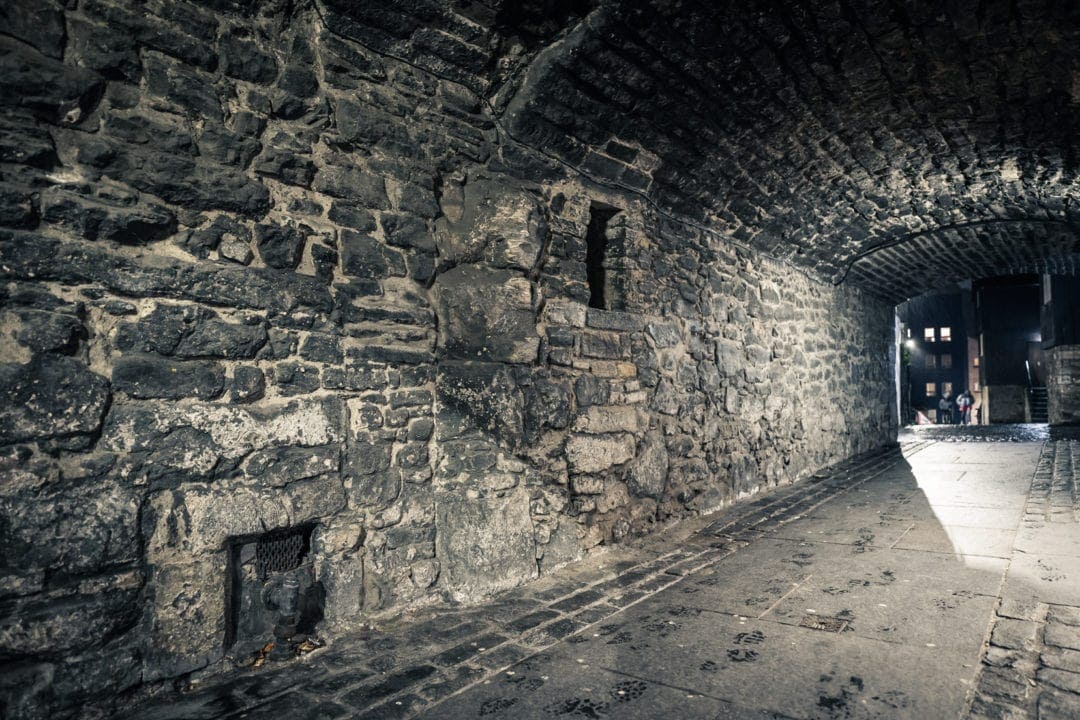
Canongate Kirk
Opposite Bakehouse Close is Canongate Kirk and its graveyard.
The cemetery is rumoured to house the body of Mary Queen of Scot’s Italian secretary, David Rizzio, who was brutally murdered in front of her. Adam Smith, the 18th-century famous economist known as the ‘Father of Capitalism’, is also buried here.
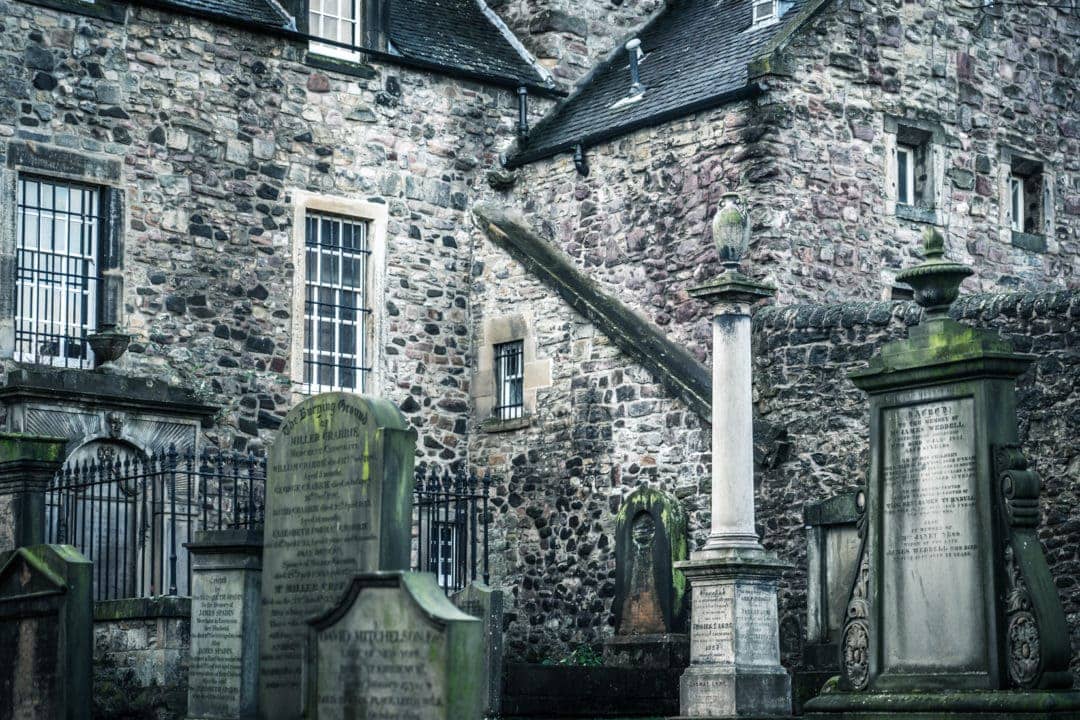
The church was completed in 1691 at the request of King James VII using funds left by a local, Thomas Moodie. A plaque at the church tells us about this. However, by the time the church was built, William of Orange had taken the throne, with King James in exile, so his coat of arms graces the church instead.
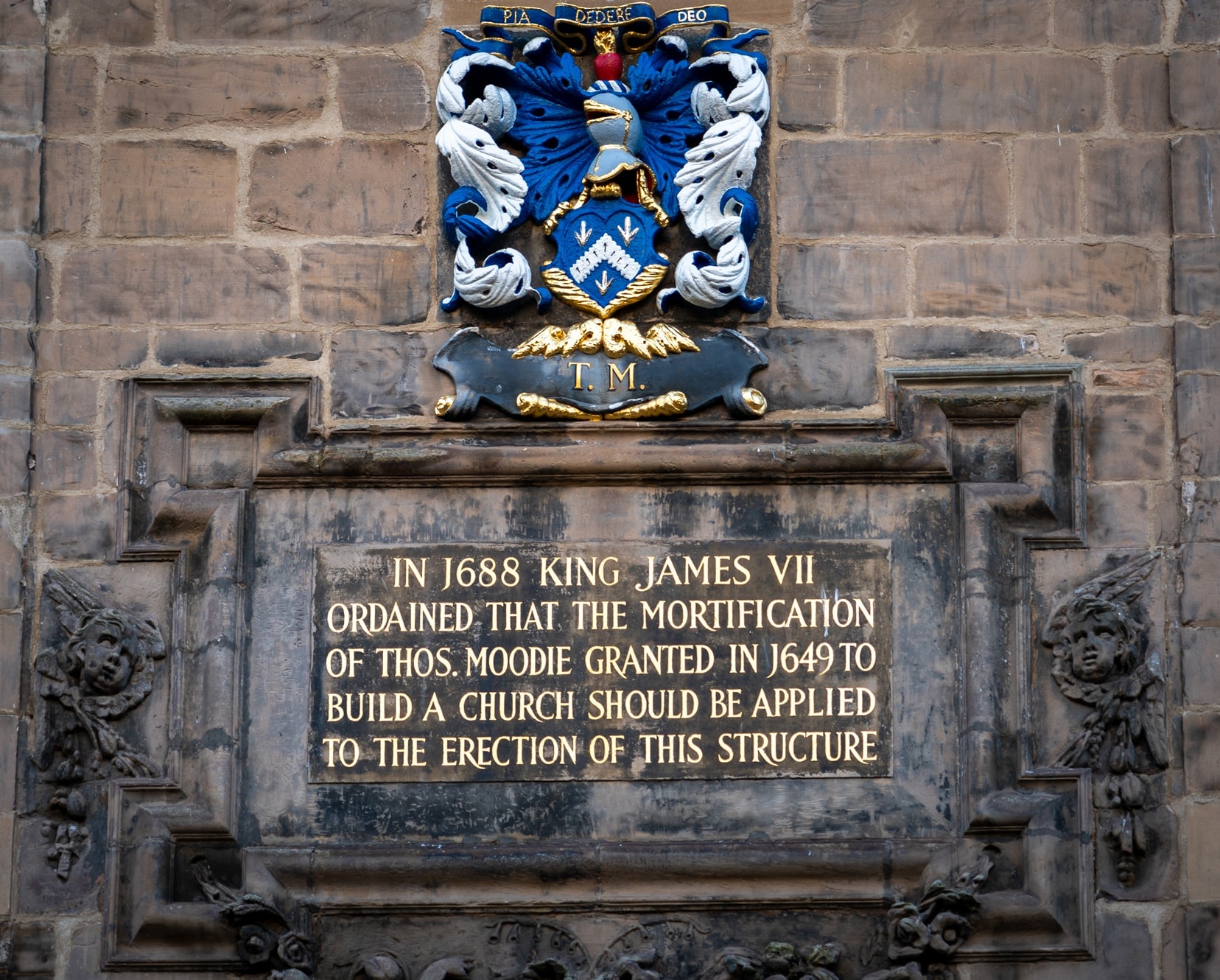
💡Remember to look up as you stroll along the Royal Mile to see many of its quirky signs, interesting embellishments and curios.
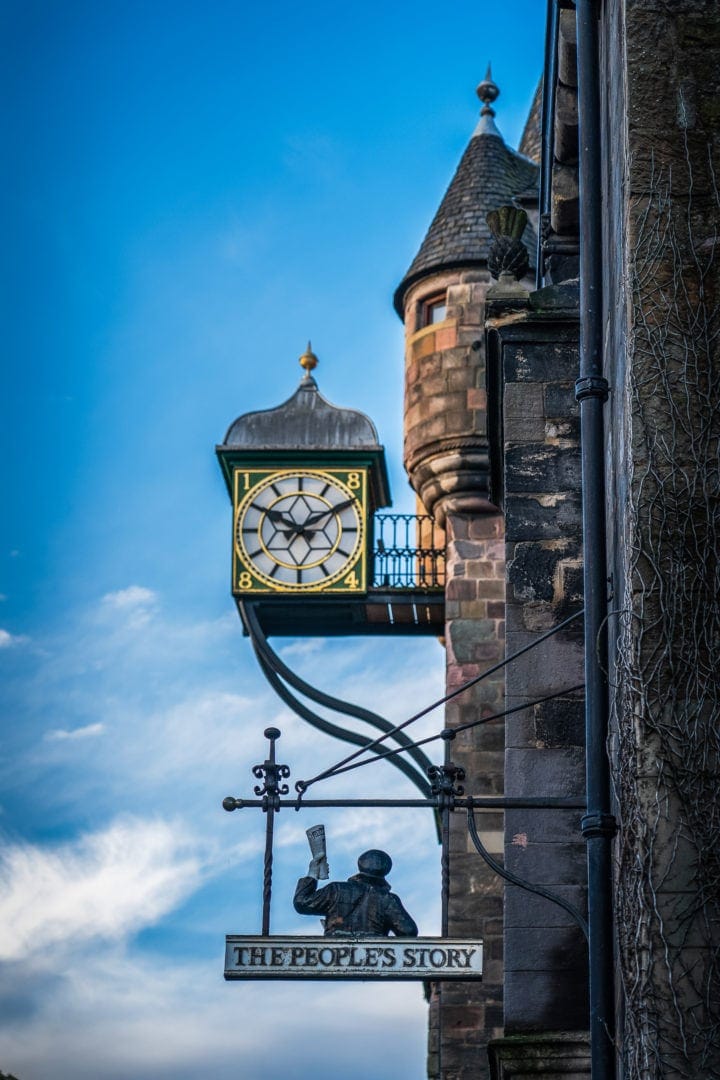
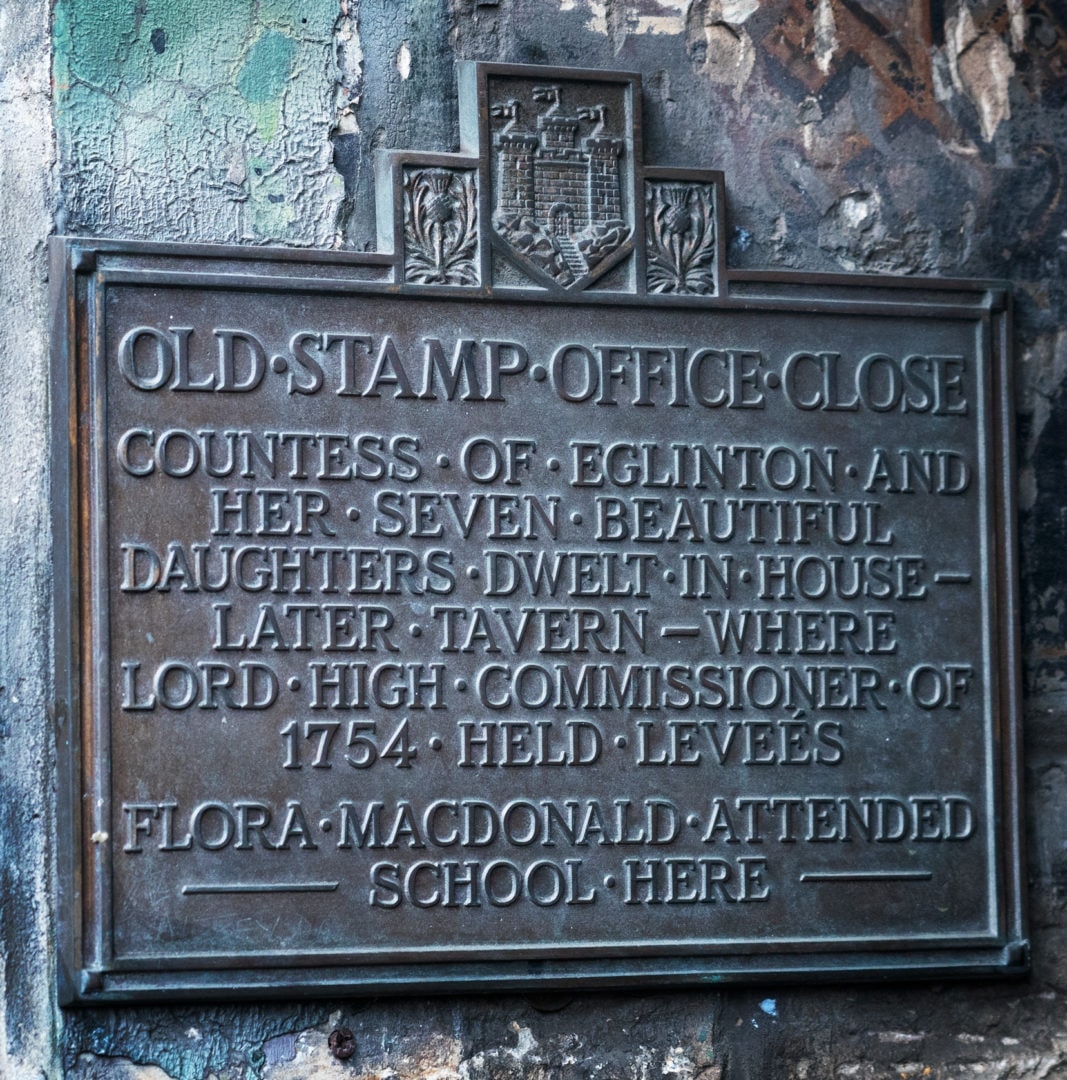
The Writer’s Museum
The Writer’s Museum is in the top part of the Royal Mile, just off Lady Stair’s Close. The pavers in the close are full of quotes from various writers, so remember to look down.
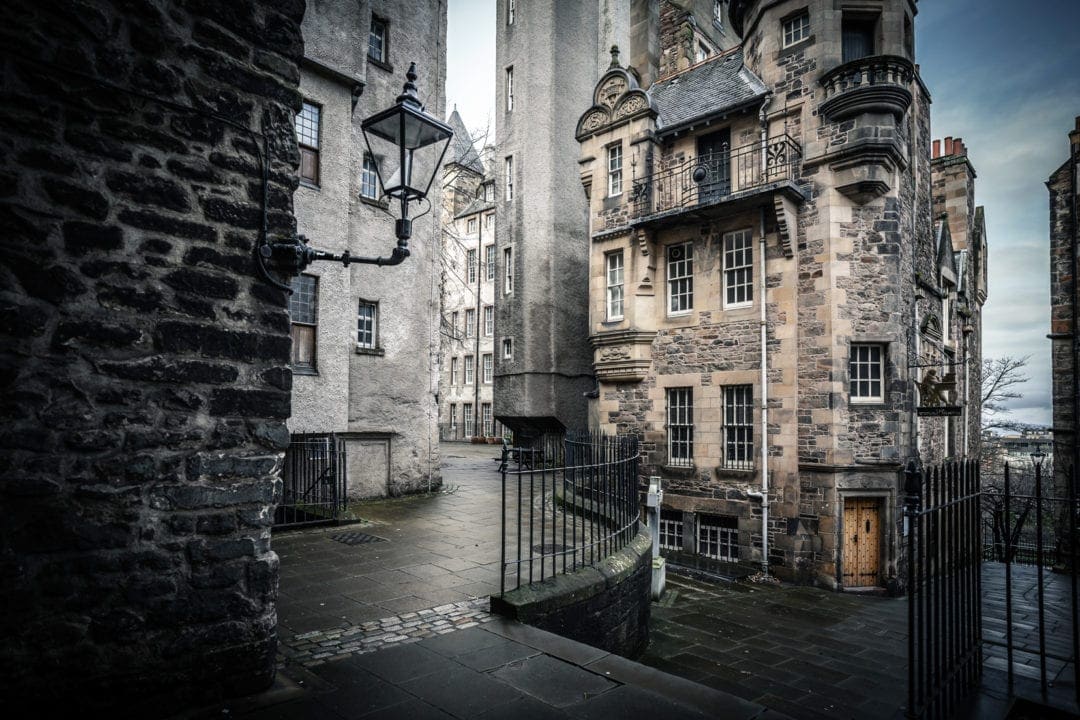
The museum itself highlights the lives and works of Robert Burns, Sir Walter Scott and Robert Louis Stevenson.
Admittance is free
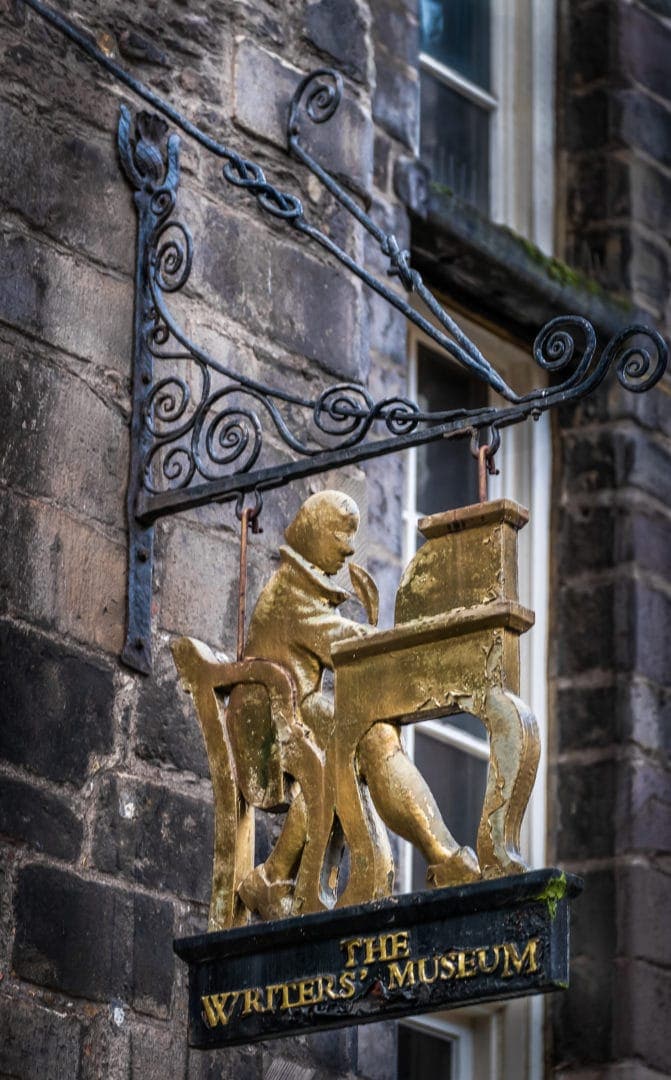
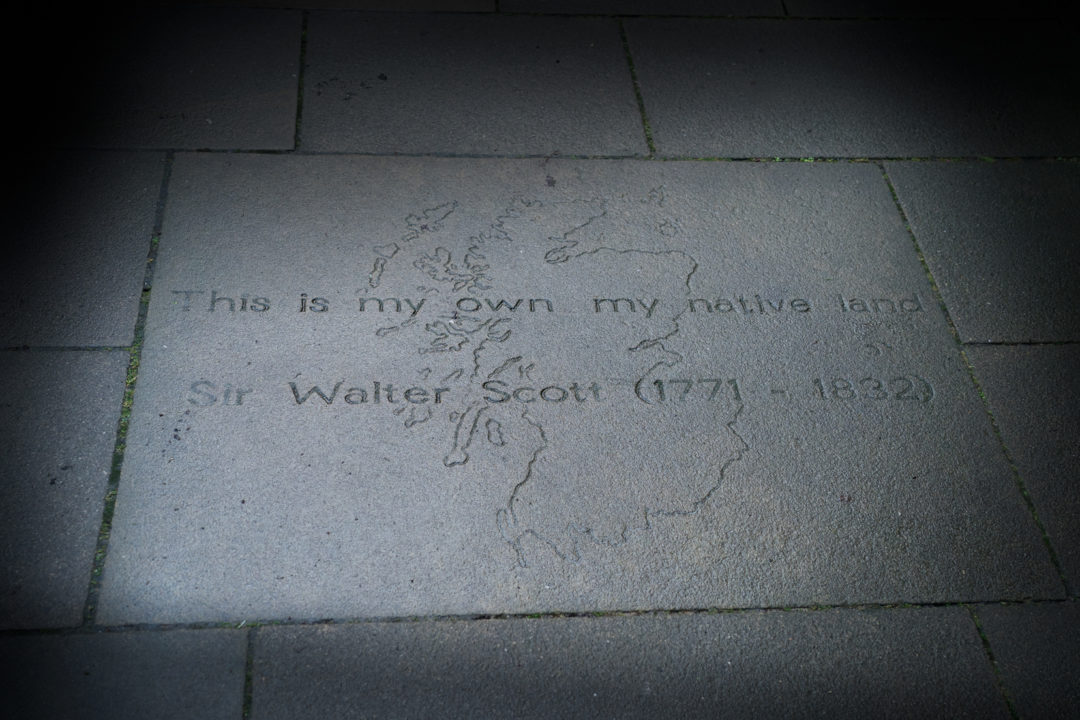
World’s End Pub
Continuing your self-guided walk along the Royal Mile, you’ll come across the World’s End Pub.
Back in the 16th Century, Edinburgh Castle was fortified with walls that stopped there. Therefore, to the community, whose whole world existed within the castle walls, this boundary was the “World’s end”.
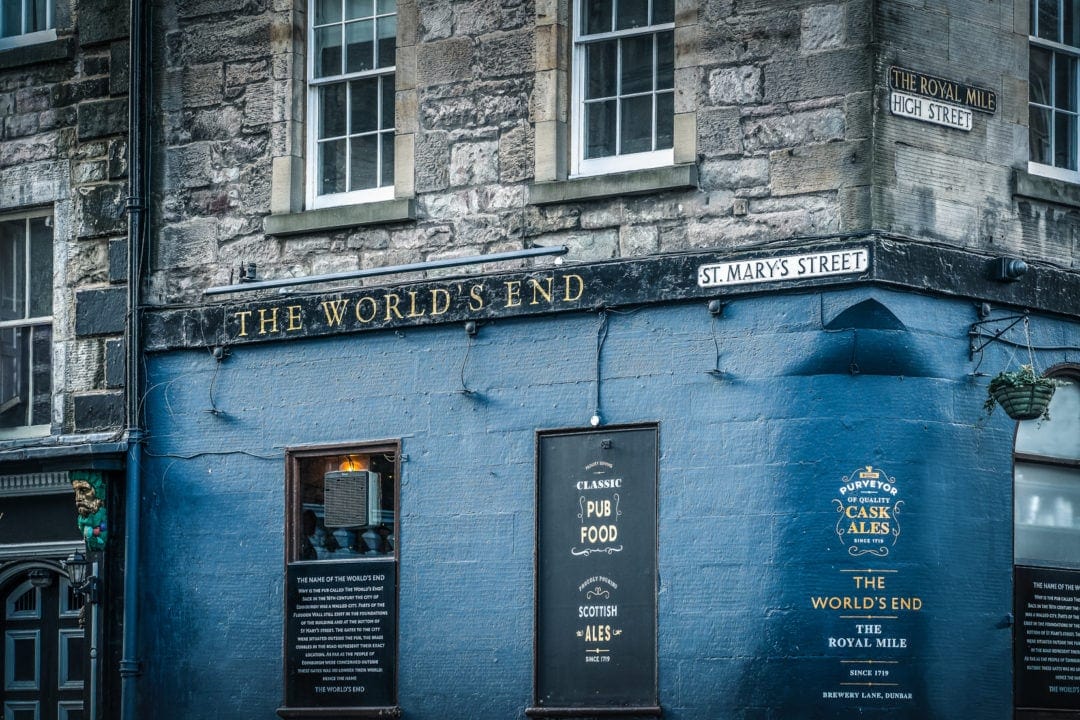
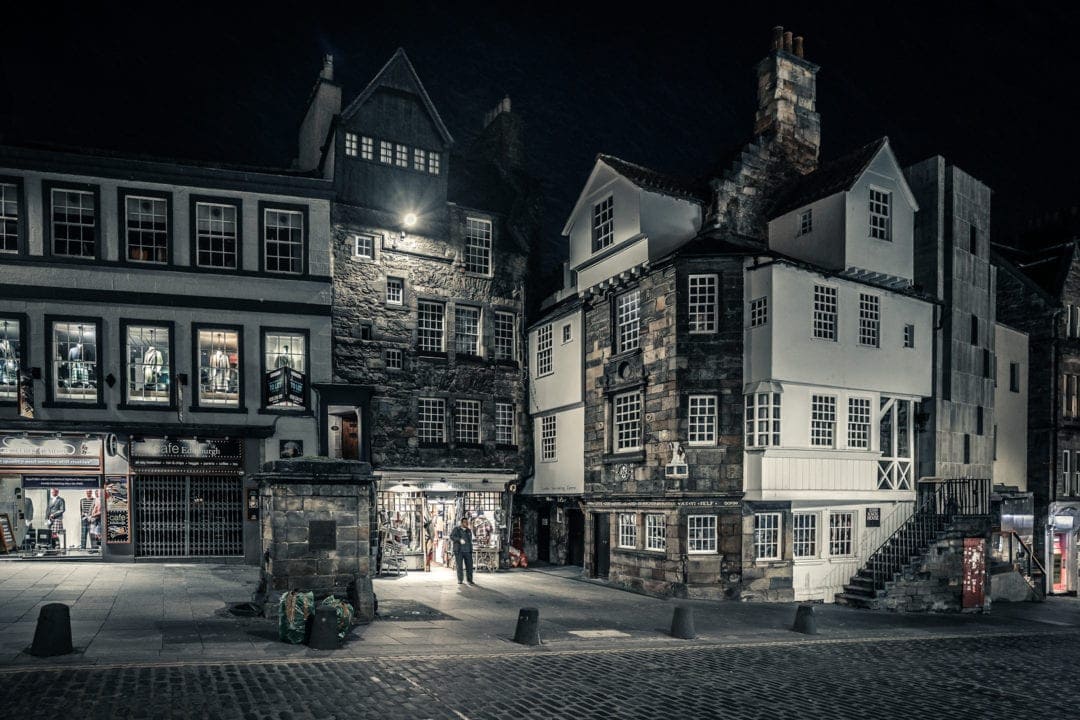
Edinburgh Castle
The final destination at the top of the Royal Mile is Edinburgh Castle. You can walk up to its forecourt and admire the views of Edinburgh from here, but you will have to pay if you want to go inside the castle.
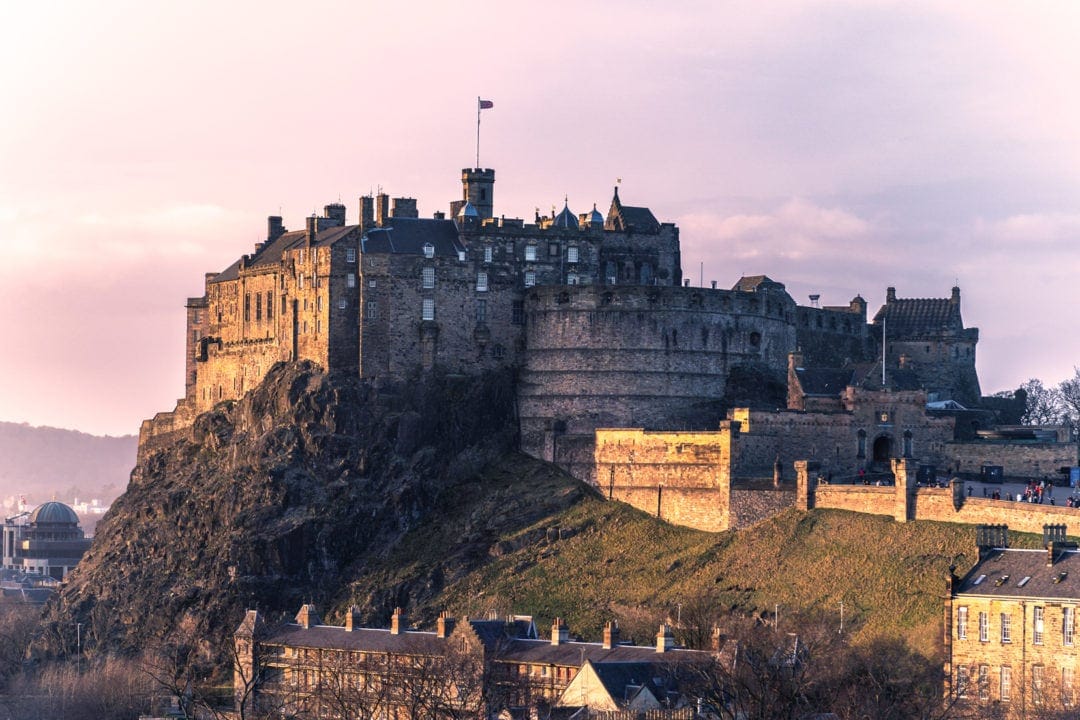
🏰 Edinburgh Castle Guided Tour
If you enjoy learning about Scotland’s Castles and are interested in the history of Edinburgh Castle, then consider booking this fantastically reviewed Castle Guide Tour.
👉 Click here for more information or to book your spot on this Edinburgh Castle Guided Tour (Free cancellation and reserve and pay later option)| ⭐️ 4.8/5| ⏰ 1.5 hours
Over 2000 reviewers have given this tour stellar rankings;
⭐️ ⭐️ ⭐️ ⭐️ ⭐️ “We absolutely loved this” — Jodie-Lee – United Kingdom, March 2023
⭐️ ⭐️ ⭐️ ⭐️ ⭐️”This was an awesome tour” — Ann – United States. February 2023
⭐️ ⭐️ ⭐️ ⭐️ ⭐️ “We were blown away” —Miranda – United Kingdom, February 2023
Members of Historic Scotland can get free entrance to the castle.
2. Grassmarket & Old Town Area
Just to the south of the Royal Mile, you’ll come to the historic Grassmarket area. Cafe and pub tables line the cobbled market square.
While we were there, Scottish tunes from one of the local kilt shops jollied the air, creating the perfect accompaniment to walking in Edinburgh.
The Grassmarket part of this self-guided Edinburgh walking tour includes the following:
- White Hart Inn (haunted pub)
- West Bow Street
- Bow Well
- The Vennel
- Greyfriars Church
- Greyfriars Bobby
- National Museum of Scotland
The White Hart Inn
From 1660, Grassmarket was the official spot for public executions, the last execution being in 1784. However, nowadays, it’s used for public markets and festivals
Unsurprisingly, a couple of the pubs here claim to be haunted. The White Hart Inn, which dates back to 1516, is the oldest pub in Edinburgh and claims it is also the most haunted.
West Bow
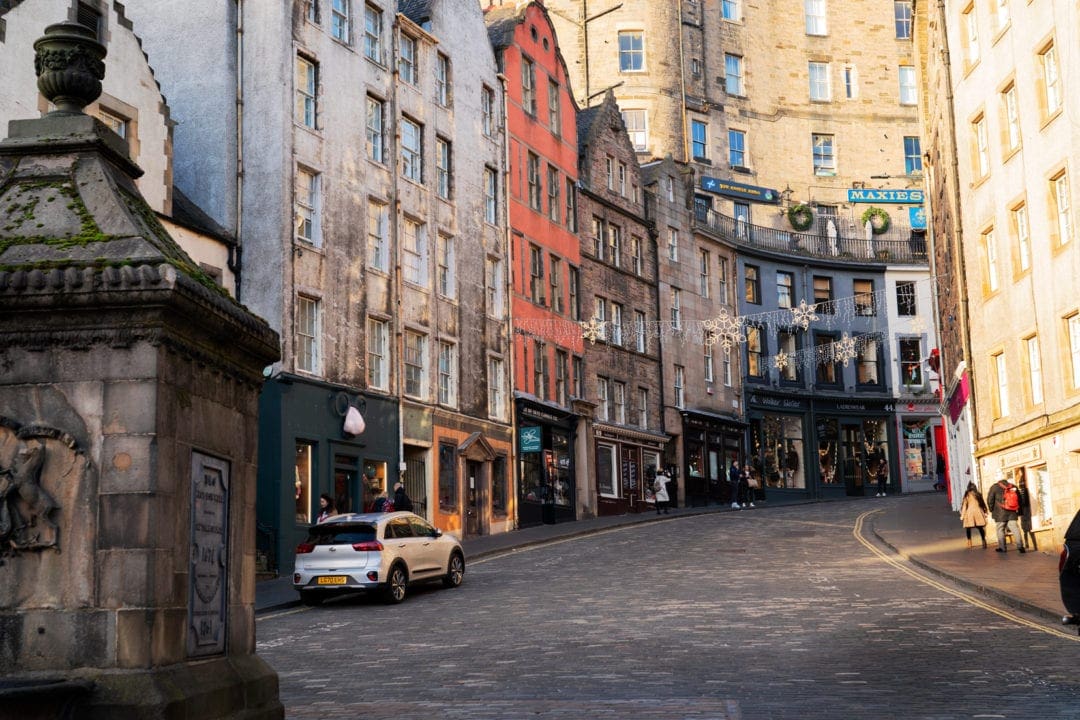
One of the most attractive streets here is West Bow (continuation of Victoria Street), a sloping road with coloured facades on its 19th-century buildings. Its olde world ambience has led to its nickname of Diagon Alley, the cobblestoned wizarding alley in Harry Potter.
Look out for the Bow Well, which was the first piped outlet of running water for the area in 1681, at the bottom of the street.
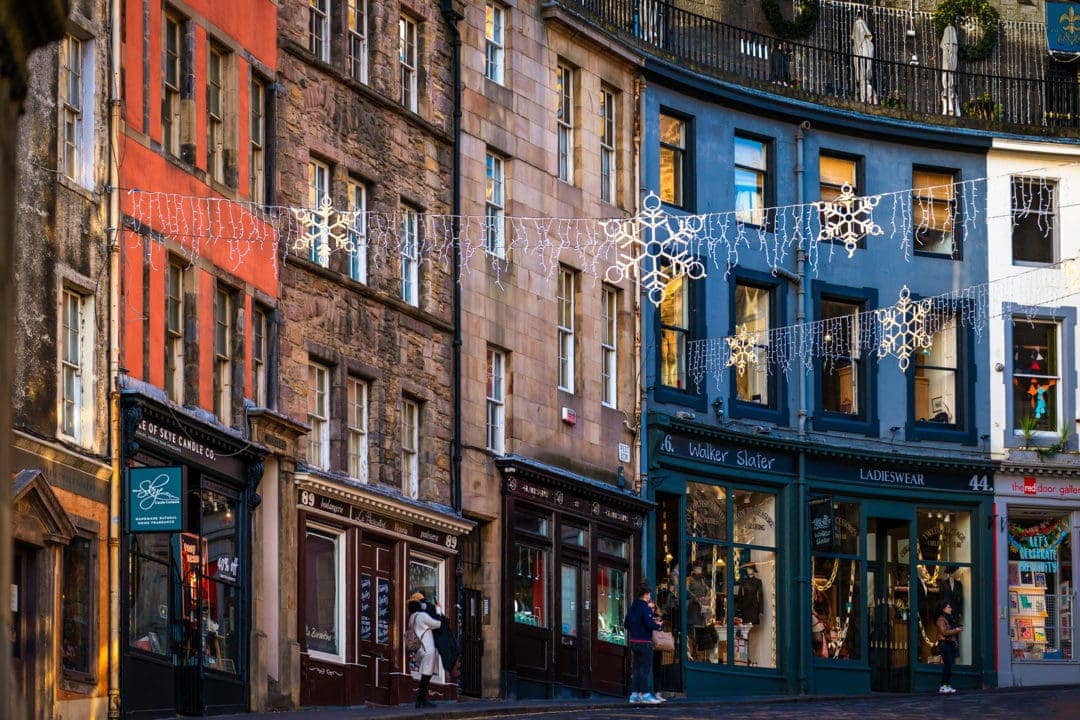
The Vennel
One of the best viewpoints of Edinburgh Castle is from a narrow alleyway off Grassmarket Square. Find the ‘Vennel’ and climb to the top of the stairs. From here, Edinburgh Castle is framed beautifully above the old houses lining the Vennel. (See map)
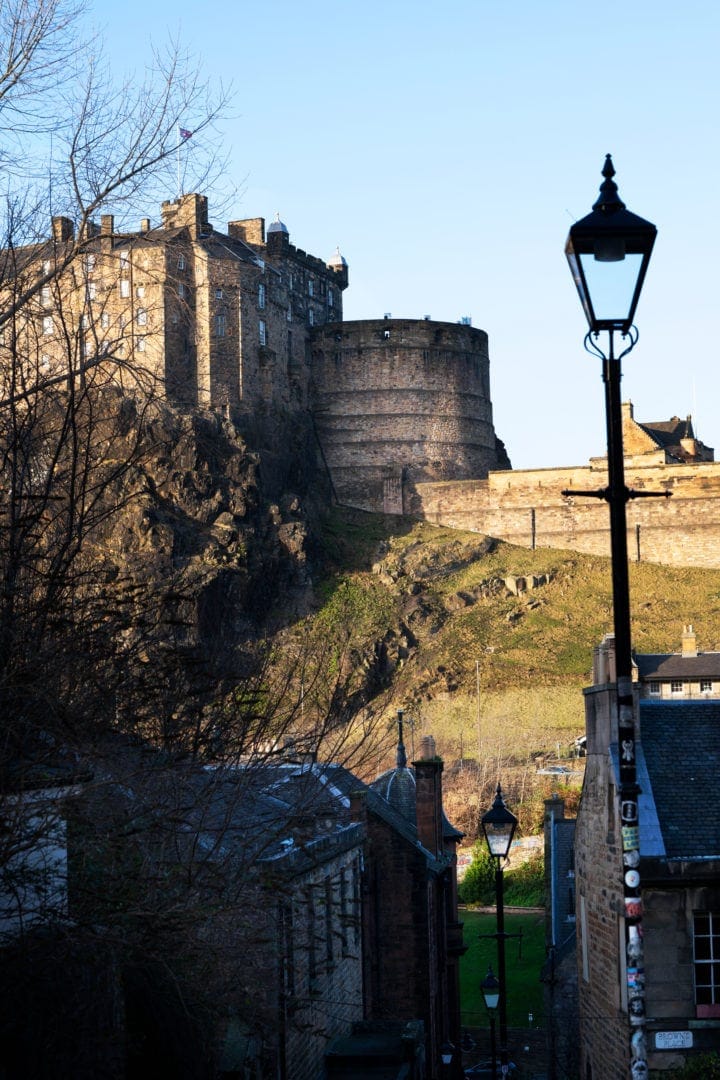
Greyfriars Church and Graveyard
Greyfriars Church and graveyard, just a few metres from the Vennel, has a connection to Harry Potter.
JK Rowling is said to have been inspired by the graves in Greyfriars, with many of the stories and characters in the Harry Potter series reflecting clues you find here.
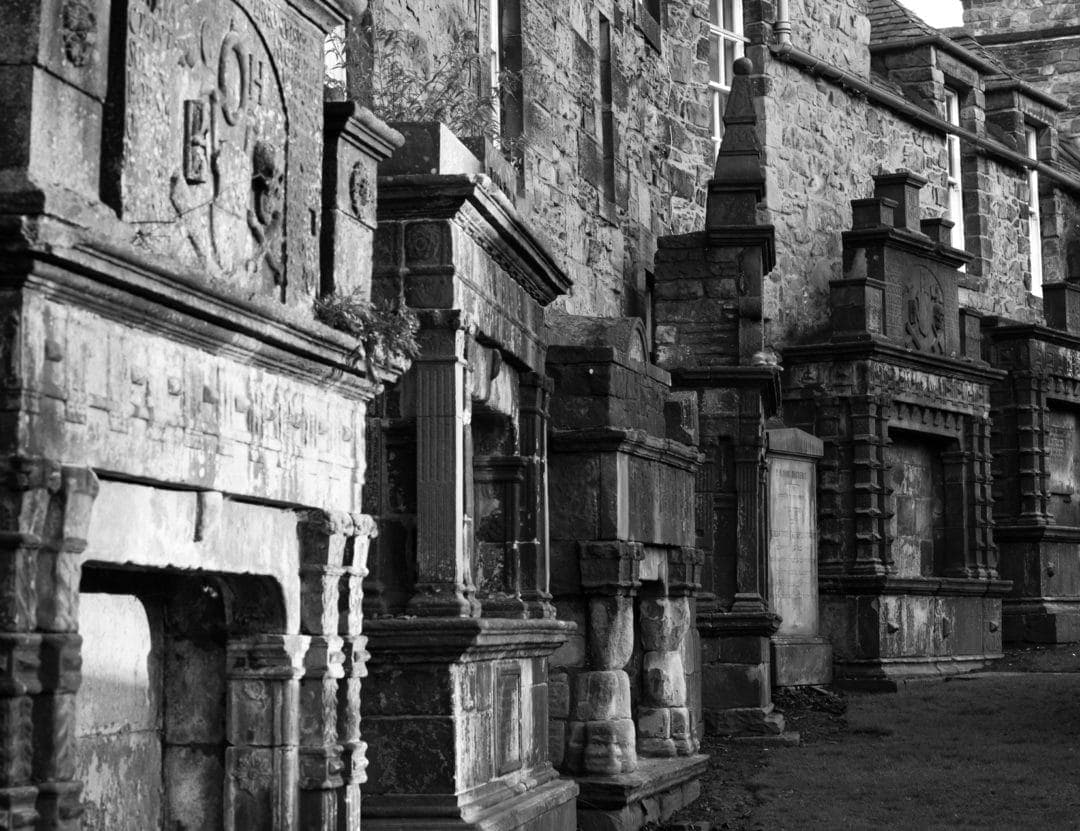
In fact, Harry Potter fans were on a walking tour while we were there. After performing some incantation, with sticks as wands, the group scuttled off with the guide to find all the links to one of the most popular book series and movies of all time.
🤎 🪄 💫 If you are a Harry Potter fan, check out this Magical Harry Potter Walking tour in Edinburgh. With over 3000 5-star reviews ⭐️⭐️⭐️⭐️⭐️ | ⏳ 2 hours … Book or read reviews here (free cancellation and reserve now and pay later)
Greyfriars Bobby
Greyfriars is also famous for its little Skye Terrier, Bobby. When his owner, John Gray, died, Bobby guarded his grave for fourteen years. This little pooch became so famous that Disney immortalised his devotion in the 1961 movie Greyfriars Bobby.
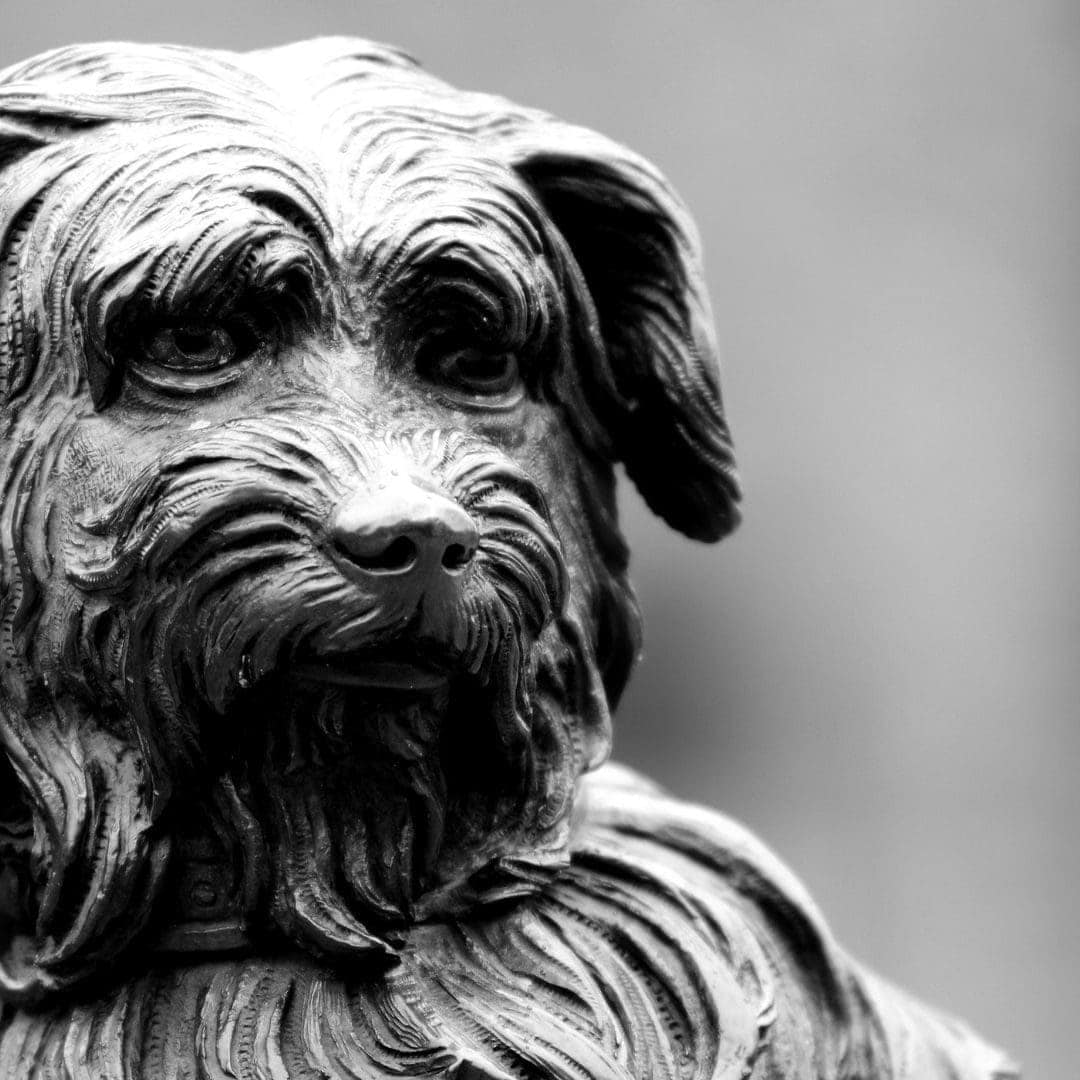
You can take a virtual tour on the Greyfriars Website here and learn more about this famous churchyard.
National Museum of Scotland
While you are walking around the old town and the Grassmarket area, stop at the National Museum of Scotland. Spread over seven levels, the museum is packed with galleries, exhibits and museum trails to follow.

While there, go to the top level to get a fantastic view out across the rooftops of Edinburgh.

3. Walking Arthur’s Seat
Arthur’s Seat isn’t just another hill—it’s an ancient, extinct volcano that’s become an Edinburgh icon. For a more detailed guide on this adventure, check out our post on how to walk to Arthur’s Seat.
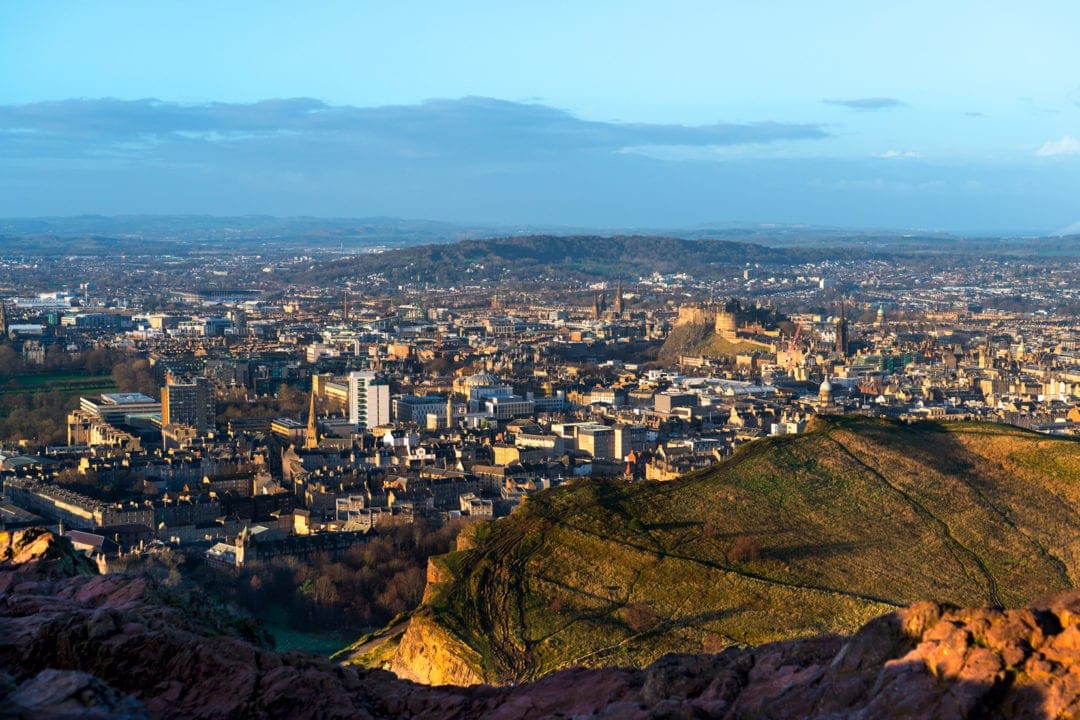
From the top, you’re rewarded with a 360-degree vista. On a clear day, you can even spot the Bridge of Forth in the distance.
Starting your ascent is a breeze. Just head to the eastern end of the Royal Mile, where you’ll find both Holyrood Palace and Holyrood Park as your starting points.
4. Calton Hill
Arthur’s Seat isn’t your only option for panoramic views in Edinburgh. As you wander the city, a glance towards Calton Hill might make you feel like you’ve stumbled upon a slice of ancient Grecian architecture.
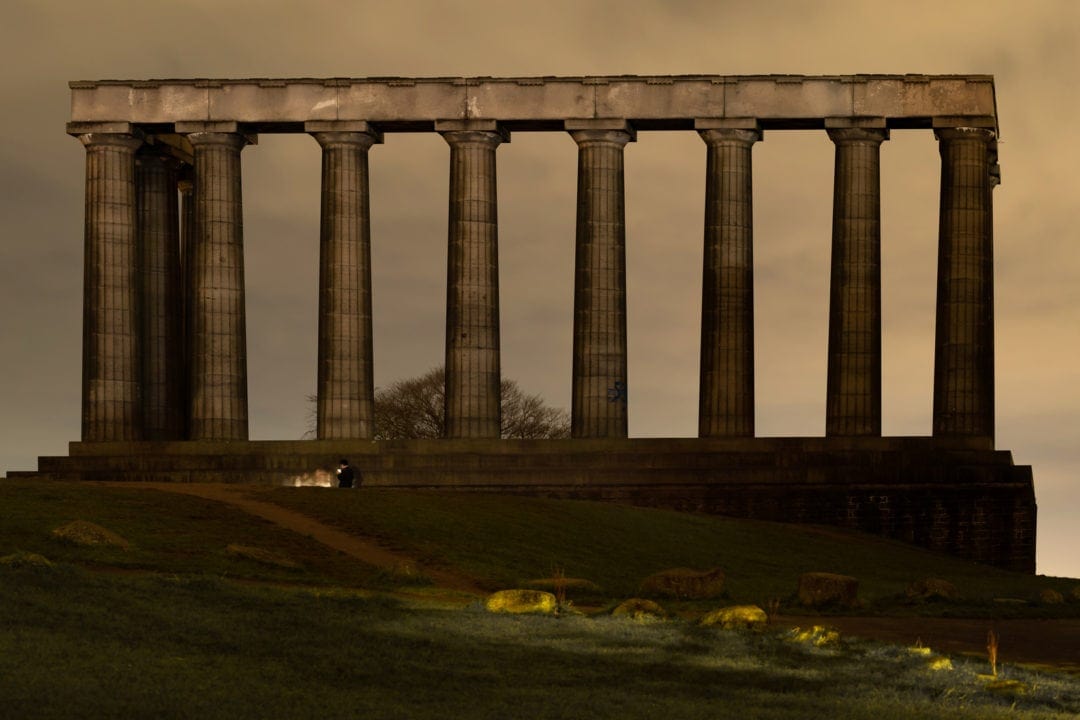
Perched high on Calton Hill, you’ll find the National Monument of Scotland. It’s a doppelgänger for Athens’ Parthenon and serves as a tribute to the Scottish servicemen who fought in the early 19th-century Napoleonic Wars.
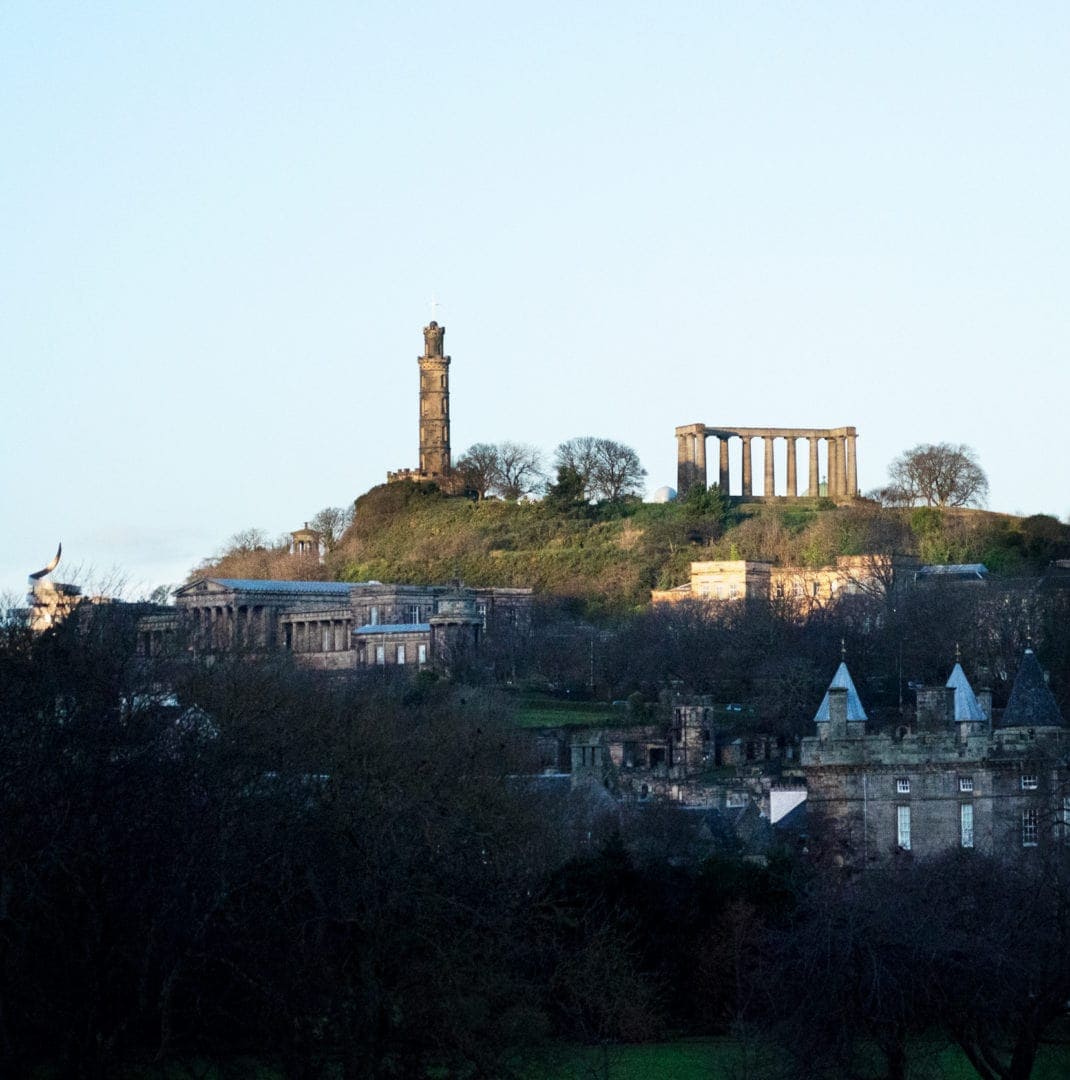
Edinburgh: Old Meets New
Edinburgh once aspired to be the Athens of the North, drawing architectural inspiration from ancient Greece. This wasn’t just a lofty claim but a statement of the city’s rising influence.
The New Town of Edinburgh was sprouting up with buildings that would make Jane Austen and Sir Walter Scott swoon. These classically inspired structures were the talk of the town, appealing to the high society of the era.
Then came the ambitious project of a replica Parthenon in 1836. But here’s the twist: due to budget constraints, the project stalled with only 12 columns erected. Locals have since dubbed it Edinburgh’s Disgrace, according to The Scotsman newspaper.
Though unfinished, this monument still commands attention on Edinburgh’s skyline. It may not have fulfilled its original purpose to honour the fallen, but it’s certainly hard to ignore.
Edinburgh’s blend of Old and New Towns makes it truly captivating. This architectural contrast adds a unique flair to Scotland’s capital. So unique, in fact, that it’s one of Scotland’s six UNESCO World Heritage Sites.
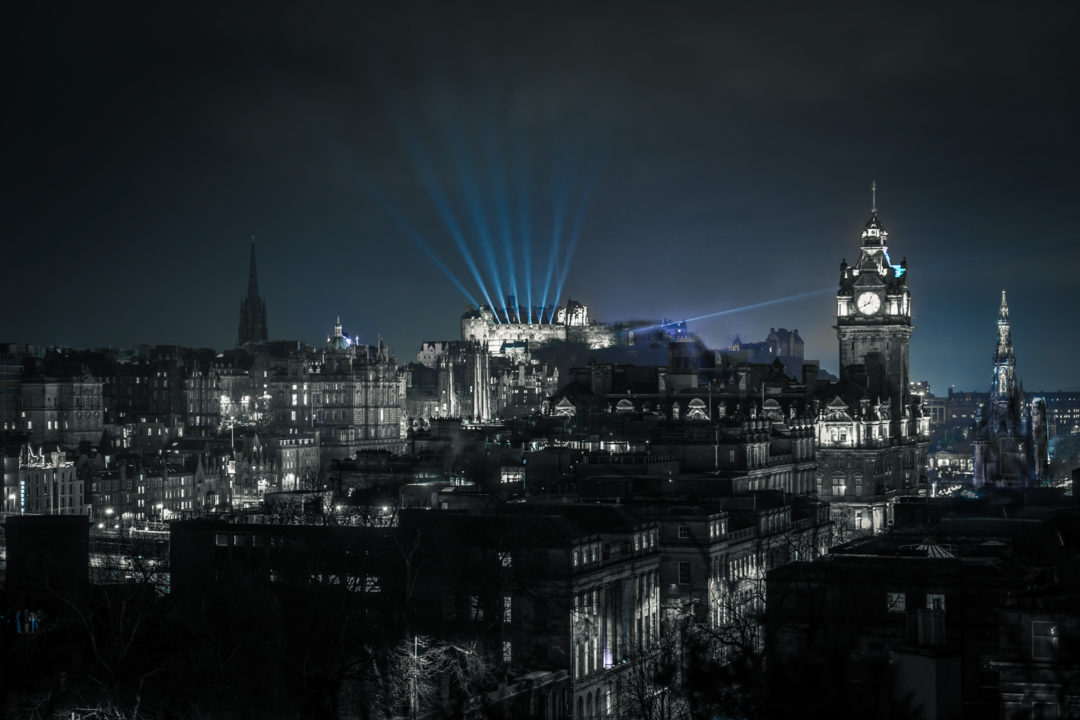
The monument you can see in the foreground in the photo below is a memorial to the Scottish philosopher Dugald Stewart.
Born in Edinburgh in 1753, Stewart was renowned for his interesting lectures and writings on moral philosophy and his scientific approach to philosophy.
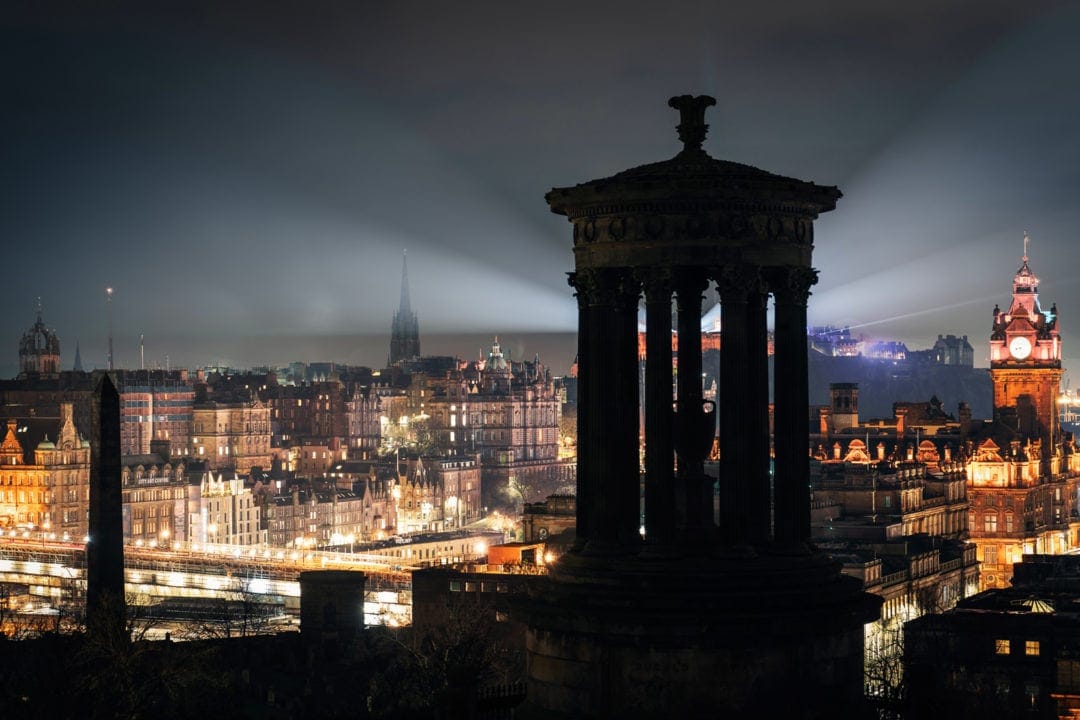
5. Duddingston Village and Lake
On the lower southeast slopes of Arthur’s Seat, nestled next to Duddingston Loch, you’ll find the historic village of Duddingston.
The village may be small in size, but we found it to have lots of character. One of Edinburgh’s most surprising and exquisite gardens is tucked away here, Dr. Neils’s Secret Garden. Two dedicated doctors, the Neils, cultivated the gardens from former sheep-grazing land. Their labour of love has transformed this space into a lush haven.
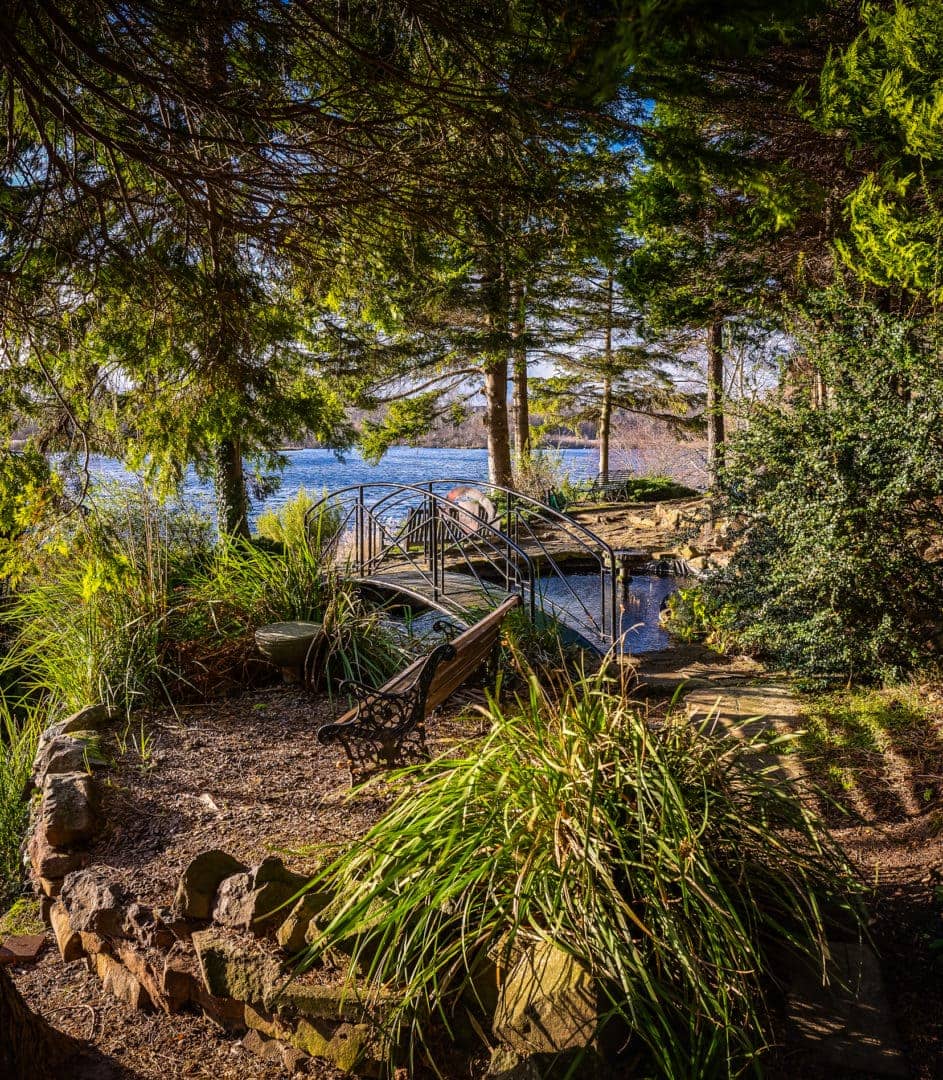
But that’s not all. The village also boasts Scotland’s oldest pub, the Sheep’s Heid, a community garden, Duddingston Kirk, and a loch teeming with birdlife.
It’s an ideal place for a picnic and the perfect escape from the hustle and bustle of the city.
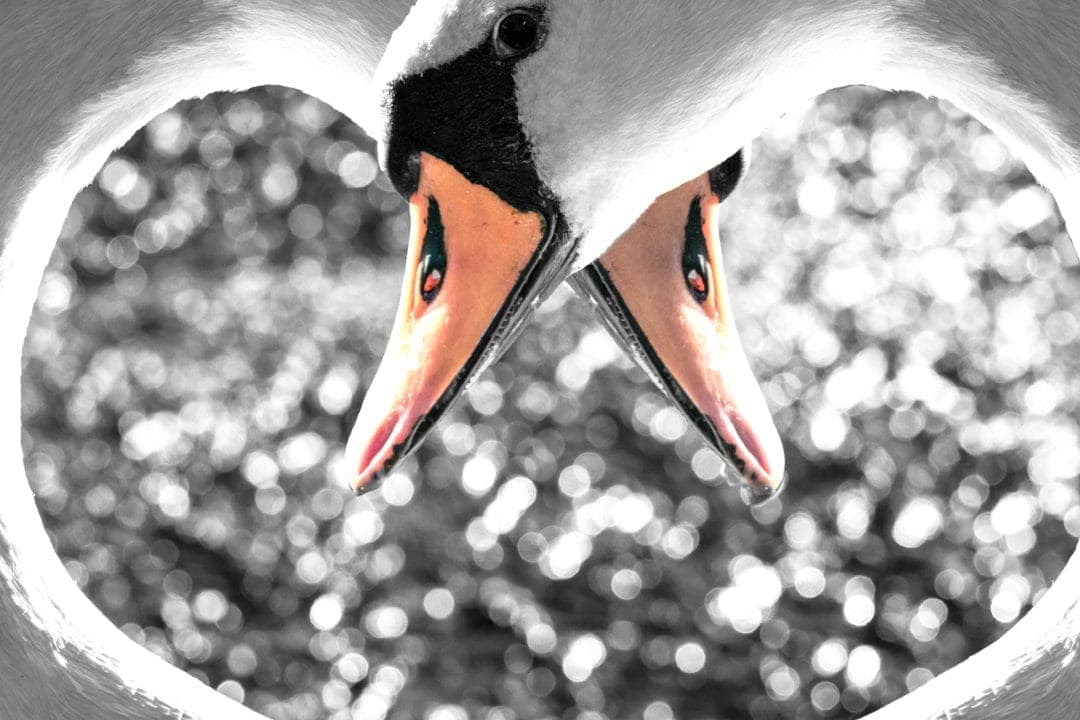
6. Deans Village & Water of Leith
Another fantastic place for walking in Edinburgh is Deans Village, a gorgeous pocket near the city’s New Town.
The Water of Leith flows through its heart, and if you’re keen, you can walk from here all the way along the river to Leith, on the coast. Dean Village is a great place to visit to capture Edinburgh’s pretty and quaint side.
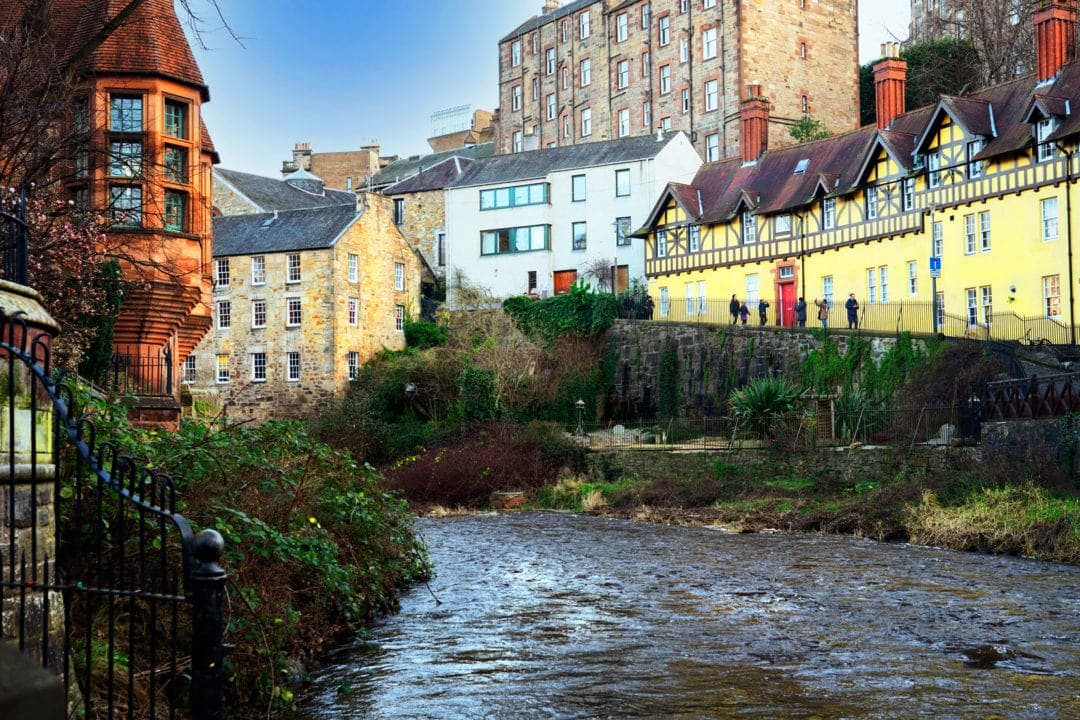
Take a walk along the Water of Leith to the old well guarded by a Greek goddess. Along the way, you’ll pass some old grinding millstones. These are just some of the remnants you’ll find in the village that hint at Dean’s Village’s past as the milling hub of Edinburgh.
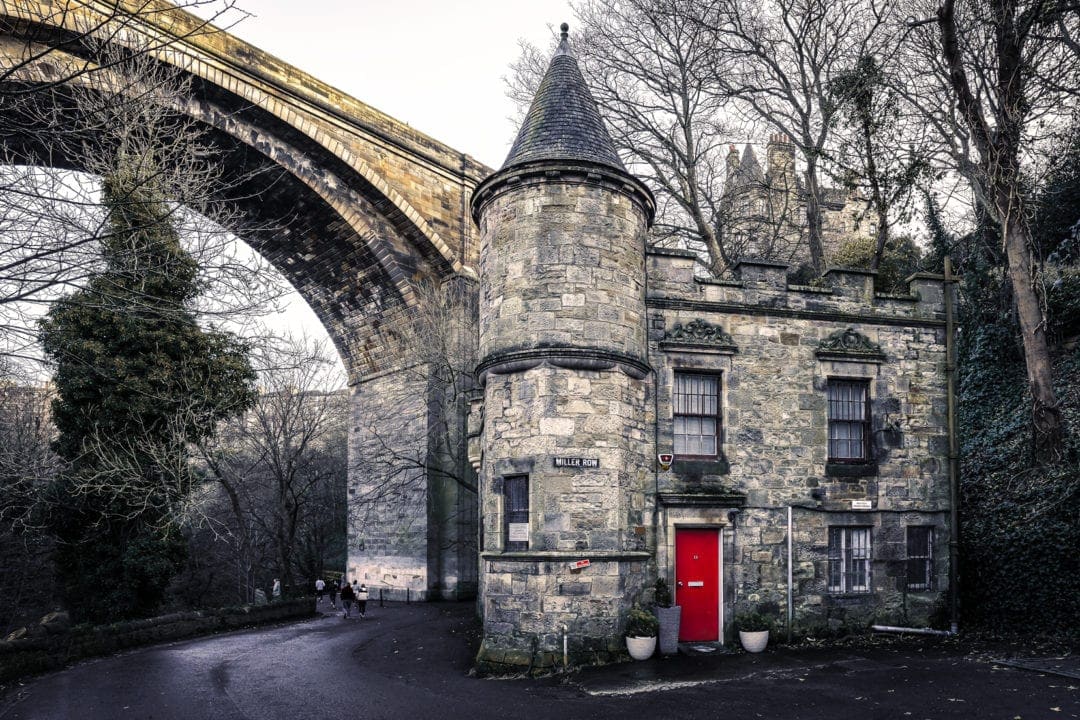
Some of the Best Walking Tours in Edinburgh
Edinburgh is a city that beckons you to explore its cobbled streets and historic nooks. But let’s face it—sometimes you want more than just a casual stroll. You crave the stories behind the stone facades, the legends that breathe life into the city.
That’s where guided walking tours come in.
I’ve found three standout walking tours that offer something a bit extra. Whether you’re a foodie, a beer enthusiast, or someone who loves a good scare, there’s a guided tour here to add that special touch to your walking tour of Edinburgh.

🧁 BEST FOOD WALKING TOUR
This 3.5-hour Secret Food Walking Tour in Edinburgh takes you on a journey into the city’s culinary history and culture.
⭐️ 4.8/5 Star Reviews| ⏳ 3.5 Hours

🍺 BEST BEER LOVERS WALKING TOUR
Enjoy this Beer Tasting Walking Tour of Edinburgh’s historic Old Town, tracing the history of the city through beer. Includes tutored tastings of Scotland’s award-winning beers.
⭐️ 4.8/5 Star Reviews| ⏳ 2 Hours
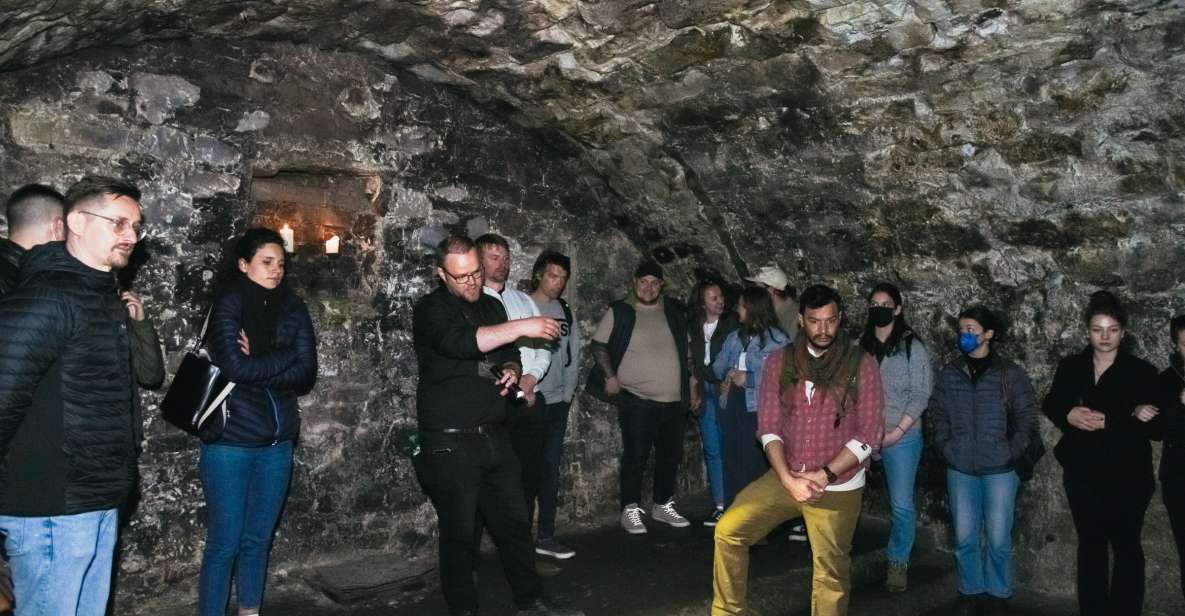
👀 BEST UNDERGROUND WALKING TOUR
This Underground Guided Walking tour takes you beneath the streets of Edinburgh’s Old Town into the vaults, reportedly one of the scariest places on earth.
⭐️ 4.6/5 Star Reviews| ⏳ 1 Hour
Walking in Edinburgh: FAQs
1. Is Edinburgh easy to Walk around?
Edinburgh is very easy to walk around. In fact, Edinburgh was named the UK’s most walkable city by a Living Streets survey in 2017, and walking is the best way to explore Edinburgh as you avoid traffic jams and parking fees.
2. What is the most Famous Walk in Edinburgh?
The most famous walk in Edinburgh is the Royal Mile. Leading from Holyrood at one end to Edinburgh Castle at the other.
3. Is Edinburgh Good for Walking?
Edinburgh is perfect for walking because there are so many places to see, and they are all within easy walking distance of each other.
4. How long Does it Take to Walk across Edinburgh?
To walk across Edinburgh, taking in all the main attractions, will take some time due to stops, but to give you an idea of walking times (without stopping), here are a few distances and times below.
👣 Dean Village to Duddingston Village: 3.6 miles, 1 hour 15 minutes

👣 Dean Village to Holyrood Palace: 2 miles, 40 minutes

👣 Holyrood Palace to Edinburgh Castle: 1 mile, 20 minutes

5. Why Walk in Edinburgh?
Edinburgh harbours a wealth of history, and as you walk its streets, you barely walk a few metres before you happen upon some reminder of its past. Its narrow cobbled wynds, closes, and alleyways branching off the main thoroughfares entice you to discover more of this esteemed city.
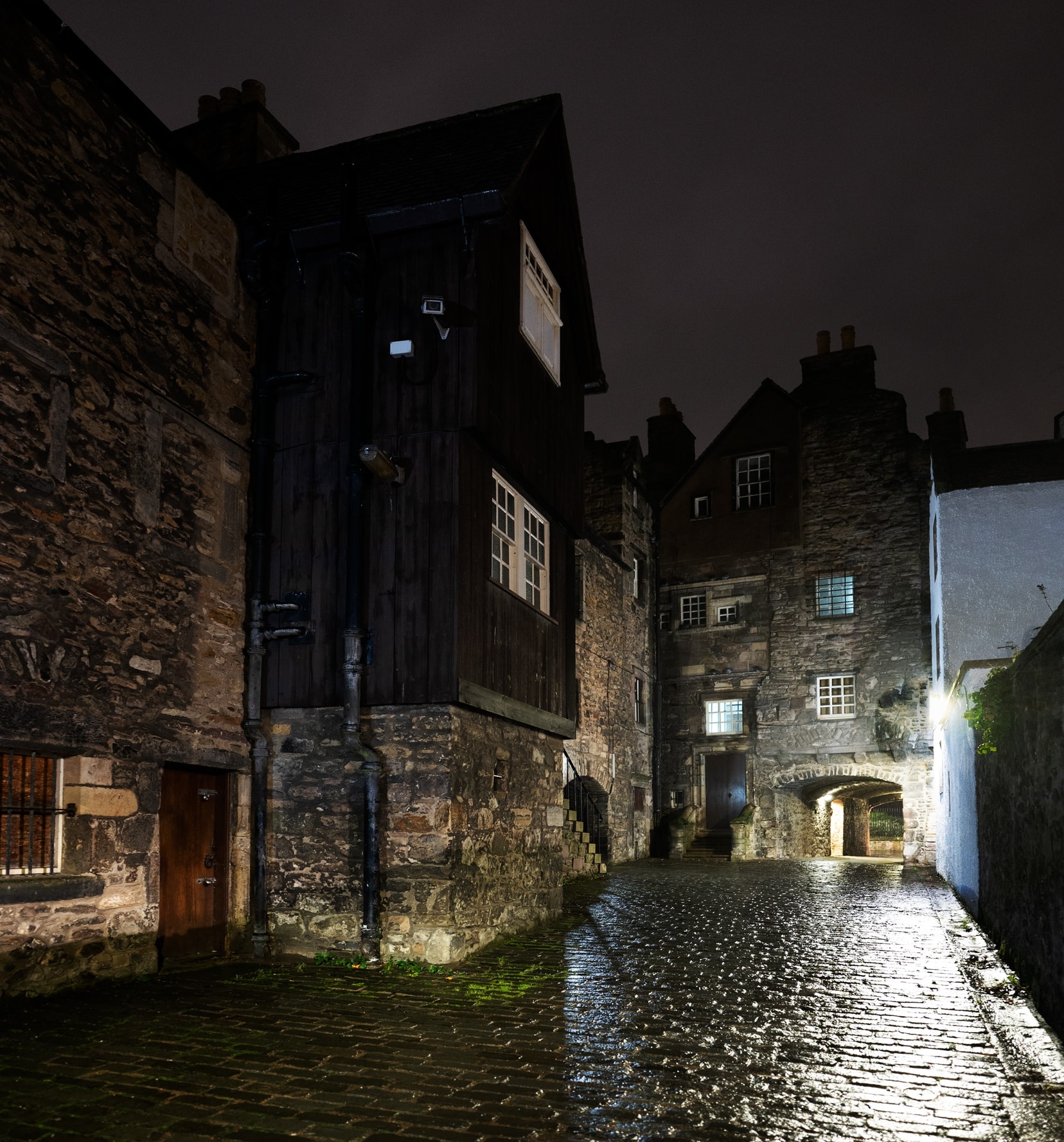
My Mixed Feelings About Edinburgh: When Cities Overwhelm

I’ve got a confession: I’m not a city person.
Walking through Edinburgh’s historic streets, I couldn’t help but feel a bit out of place. Don’t get me wrong; Edinburgh is a gem. It’s rich in history, and every corner seems to whisper tales from the past.
The Noise and the Crowd: A Constant Hum
Sometimes, the allure of cities fades when I’m confronted with the incessant noise of traffic and crowds. It’s like a constant hum that drowns out any historical charm.
When Expectations Meet Reality
And it’s not just the noise; the hustle and bustle often diminish the sense of awe I’m looking for. Perhaps my obsession with the TV show Outlander and the romanticised history of Scotland set my expectations a bit too high.
A Moment of Reflection: Interrupted
Sitting on the steps of an ancient market cross, I watch a discarded McDonald’s bag blow around my feet. The reflective moment of imagining what went on around this historical cross centuries ago scatters away in the breeze. I catch the hapless bag and toss it into the overcrowded bin.
The Quest for Authenticity
A rude jolt back to reality. I yearn for the unspoiled, the authentic. I want to touch ancient stones and feel connected to the past.
The City’s Sonic Landscape
But cities often make this difficult, shattering my imaginative journey back in time. Horns honk, sirens blare, and youngsters drive by with sound systems on full volume, the boom-boom vibrations shocking even the airwaves.
The Elusive Silence
I hanker for the sound of silence.
The Struggle with Imagination
The city’s past beckons with its wrinkled finger, promising portals into a world we can only now imagine. I want to step through these city portals. I really do. But I’m not so good at imagination, it seems.
The Urban Dilemma
My visions are shattered by people, cars, rubbish bins, and ‘boom booms’ bombarding my brain. I realise I’m not made to blend with the hordes. I am not built for urban life. I yearn to escape the run-of-the-mill, everyday routine. Cities scramble my signals.
The Silver Lining: Lessons from the City
Cities may scramble my signals, but they also teach me something valuable. They remind me why I chose this life of travel—to explore, reflect, and grow. And yes, to confirm that cities are not my cup of tea.
The Road Less Travelled
But that’s okay. The world is vast, and there’s room for all kinds of adventurers, even those who prefer the road less travelled.
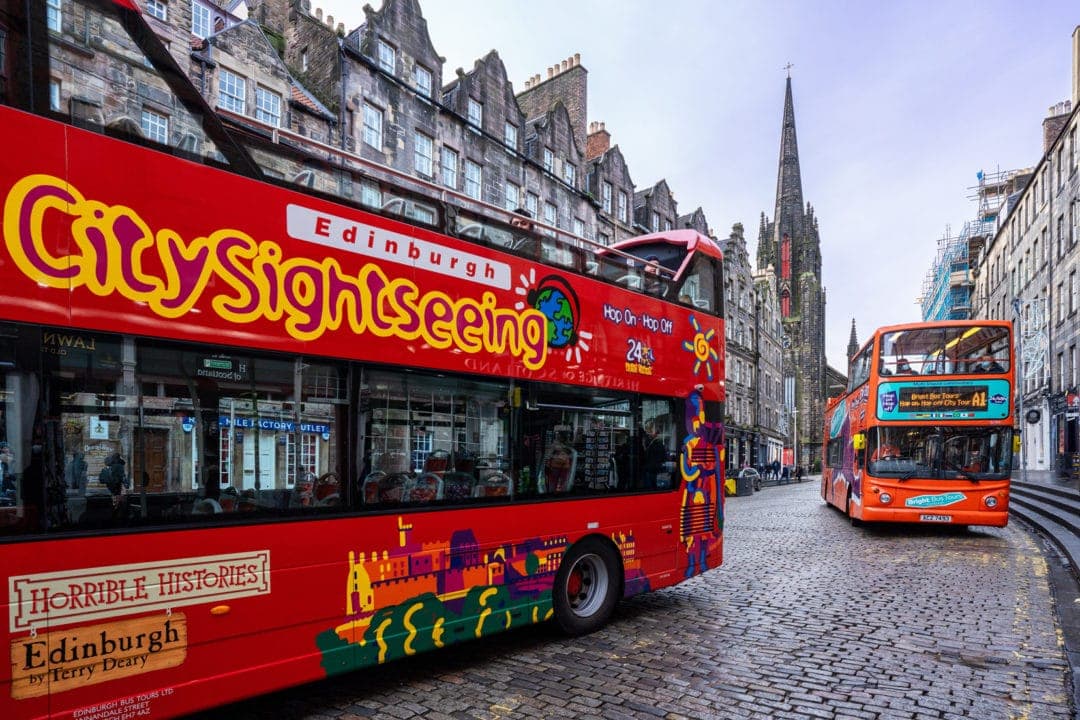
Self-Guided Walk Edinburgh… That’s a Wrap
So, cities aren’t my cup of tea. But Edinburgh is different.
It’s a city that feels like a collection of villages, each with its own unique charm. From the historic allure of the Royal Mile to the serene beauty of Duddingston and Dean Villages, Edinburgh offers a diverse range of experiences within its city limits.
So, whether you’re a city slicker or more of a village wanderer like me, Edinburgh has a path for you. Why not take a walk and find yours?
Are you following us? Say hello on Facebook or Instagram

Pin and Save for Later
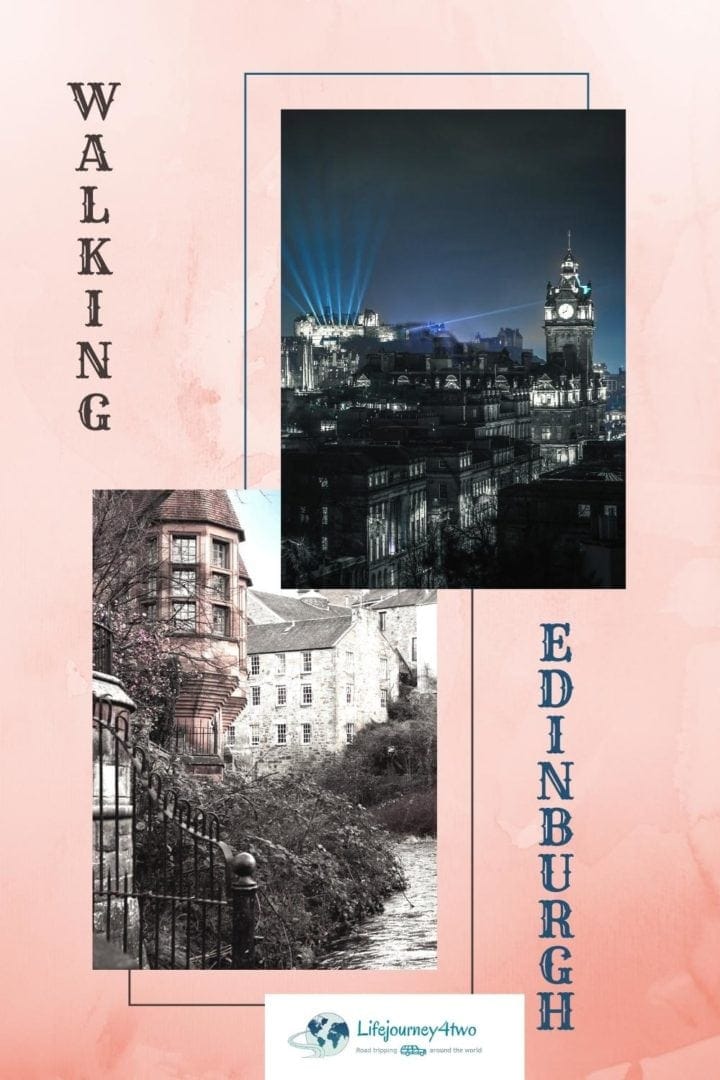
You May Also Like to Read:
Planning Your Travels?
These are the travel resources we recommend and use when planning our trips.
- 🚘 Car Hire: We use DiscoverCars.com
- Motorhome/Campervan Rental: We highly recommend the Motorhome Republic
- 🪪 Order your International Driver’s Licence online here
- 🛏 Book Accommodation: We use Booking.com to find accommodation that suits our budget
- 🐶 Pet Sitting/Pet Sitters: Check Out TrustedHousesitters here (Use our Discount code: LIFEJOURNEY25 for 25% off. )
- Activities and Experiences: Get Your Guide and Viator
- Travel Insurance: Safetywing or World Nomads
- 🥾 Travel Gear and Accessories: Check out our top picks here — Lifejourney4two page on Amazon
For a more thorough list, visit our Travel Resources page here.

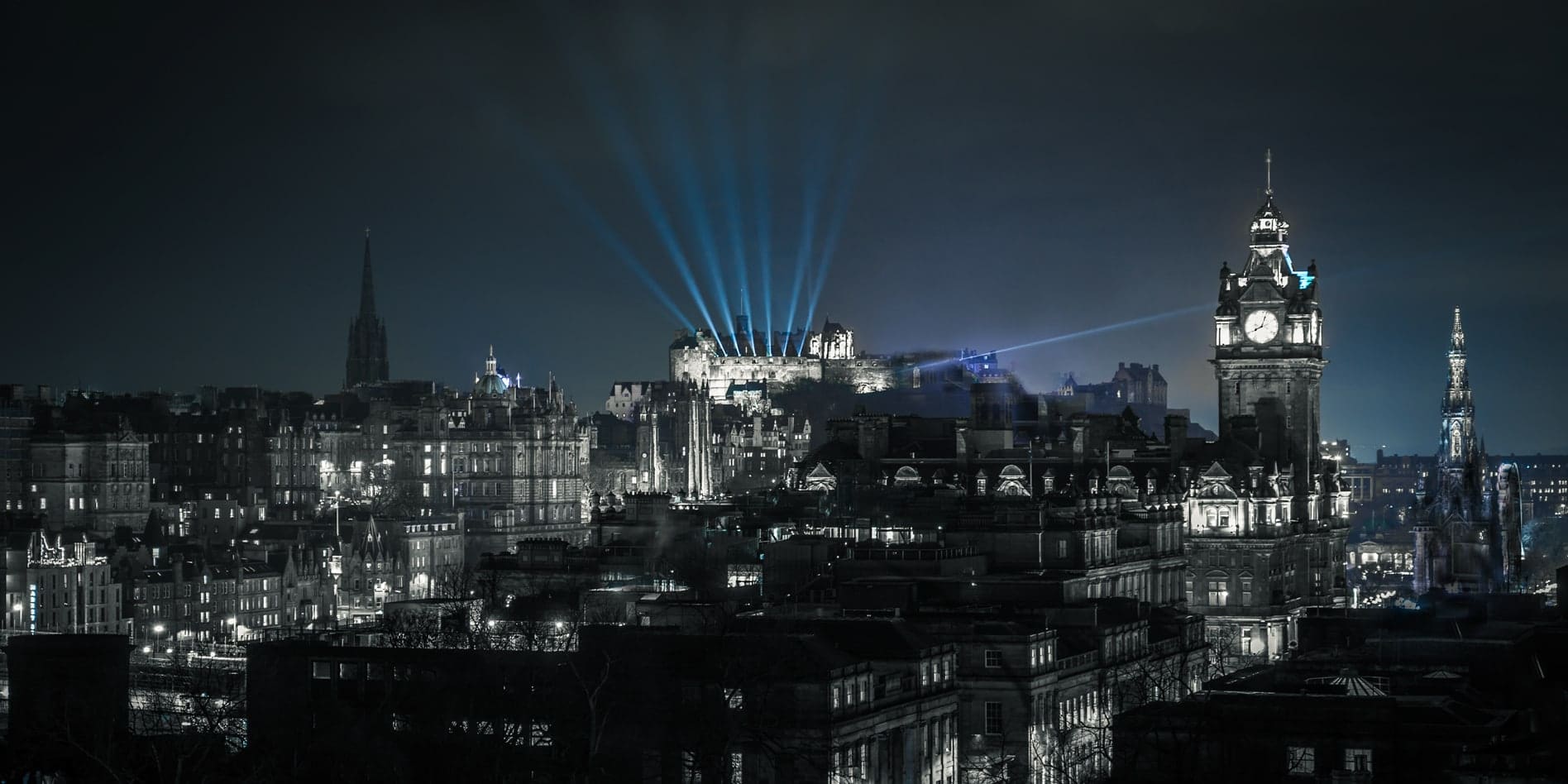
Great photos of some iconic Edinburgh landmarks. I love the People’s Story Museum, but my favourite on the High Street was always the Museum of Childhood. We used to spend wet Sunday afternoons in the National Museum when the children were little. Fond memories!
Thanks for sharing your memories Jane – there are so many interesting places to keep a visitor busy here 🙂